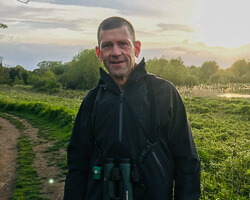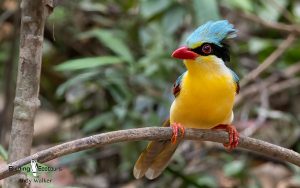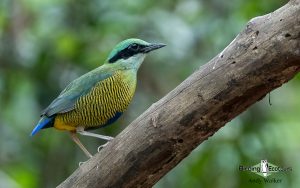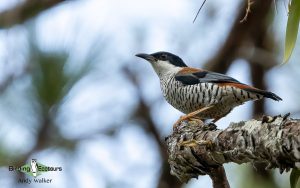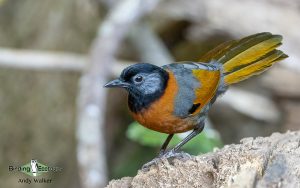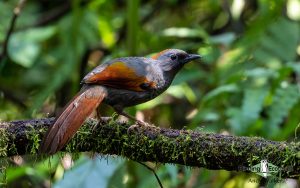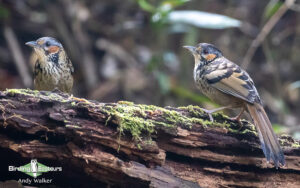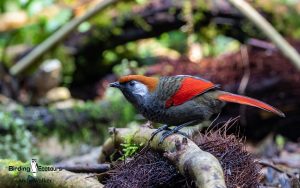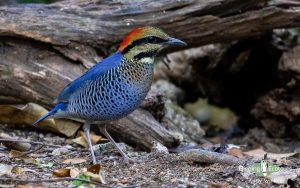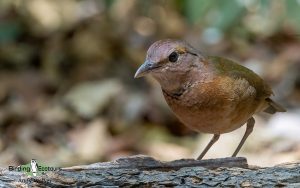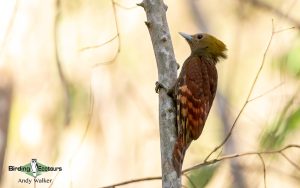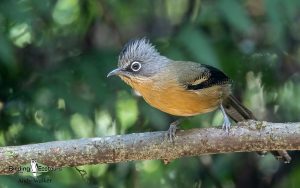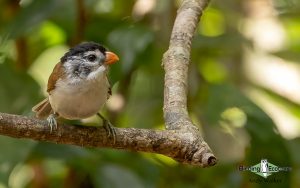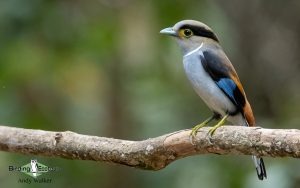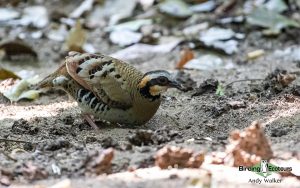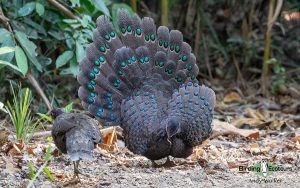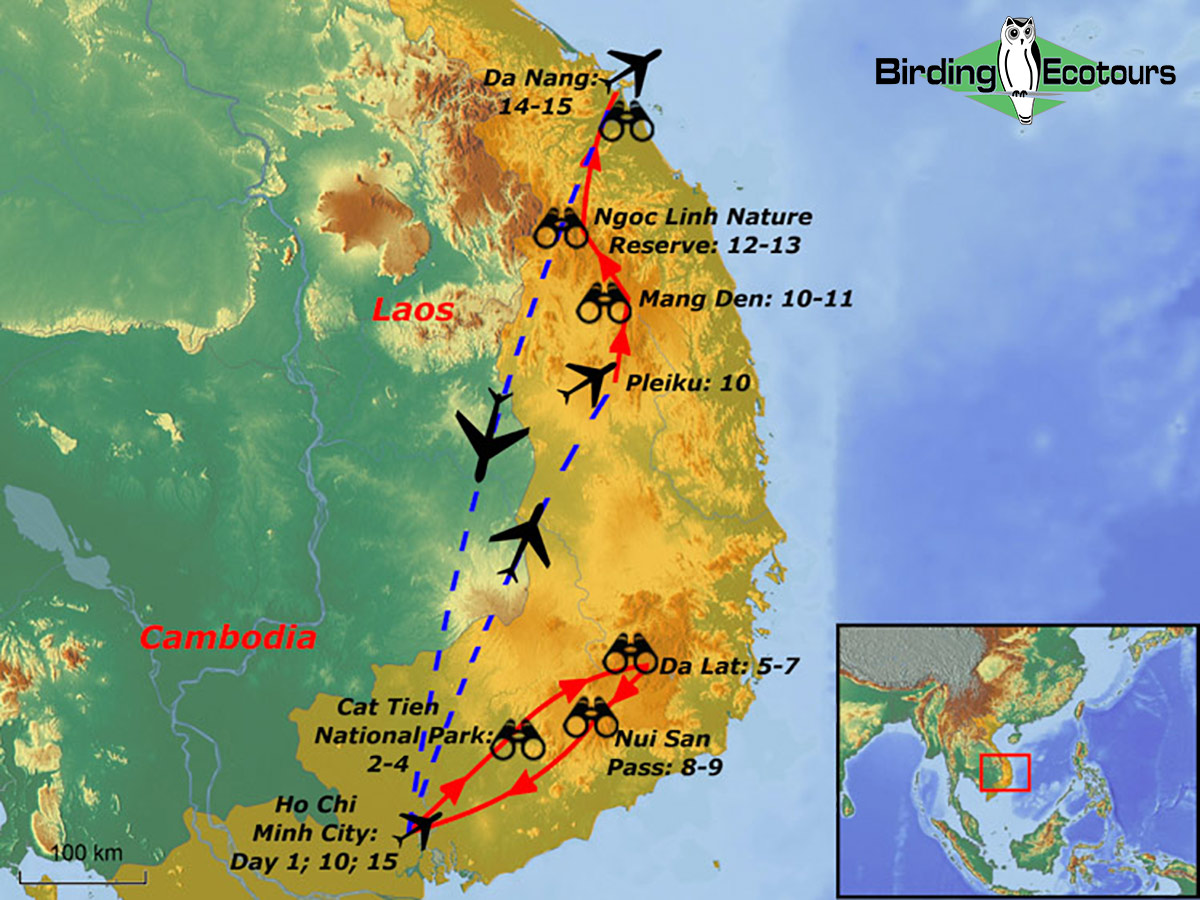Birding Tour Vietnam: Southern and Central Vietnam Endemics and Specialties
Go to: Vietnam Birding Tours | Birding Tours in Asia | All our birding tours
Birding Tour Vietnam: Southern and Central Vietnam: Endemics and Regional Specials
Extra-small-group birding tour
March 2026/2027
This extra-small, small-group birdwatching tour to central and southern Vietnam starts and ends in Ho Chi Minh City, formerly known as Saigon. This birding tour is a guaranteed departure with just four tour participants and has a maximum of just five tour participants, making it one of the most exclusive birding tours in Vietnam, with unrivalled viewing opportunities of great birds.
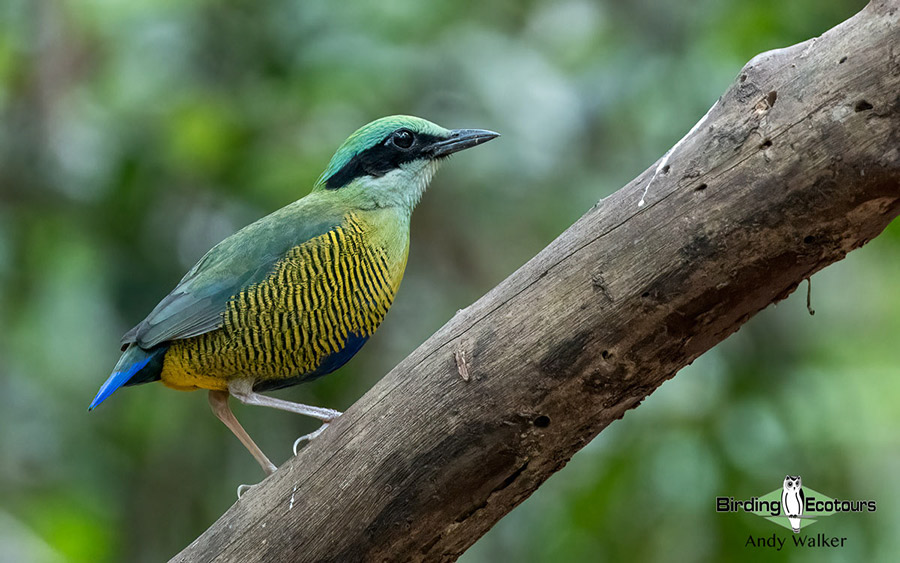
The tour focusses on finding as many of the endemic, near-endemic, and special birds of the region and provides excellent opportunities for anyone wanting to photograph Asian birds. We will visit the well-known sites of Cat Tien National Park, the Da Lat and Di Linh Plateaus, Mang Den, and Ngoc Linh Nature Reserve, as well as some less-well-publicized sites for specific target birds. By being in a very small group we will be able to utilize a series of bird blinds (bird hides), which will allow for some excellent photographic opportunities and close-up views of some of the key (and often secretive) species outlined below. A small group will also be beneficial when birding within the forest environments, enabling everyone to stand a higher chance of gaining great views of the many birds that are possible on this very exciting tour.
Some of the key species we will look for during the tour include, but are certainly not limited to, Bar-bellied Pitta, Blue-rumped Pitta, Blue Pitta, Rusty-naped Pitta, Siamese Fireback, Silver Pheasant, Green Peafowl, Germain’s Peacock-Pheasant, Orange-necked Partridge, Pale-headed Woodpecker, Necklaced Barbet, Red-vented Barbet, Long-tailed Broadbill, Silver-breasted Broadbill, Green Cochoa, Orange-breasted Laughingthrush, Chestnut-eared Laughingthrush, Golden-winged Laughingthrush, Red-tailed Laughingthrush, White-cheeked Laughingthrush, Black-hooded Laughingthrush, Brown-crowned Scimitar Babbler, Red-tailed Minla, Indochinese Fulvetta, Black-crowned Barwing, Short-billed Scimitar Babbler, Indochinese Green Magpie, Ratchet-tailed Treepie, Dalat Bush Warbler, Vietnamese Greenfinch, Vietnamese Cutia, Grey-crowned Crocias, and plenty more. The tour also offers excellent animals, including gibbons, monkeys, and interesting reptiles.
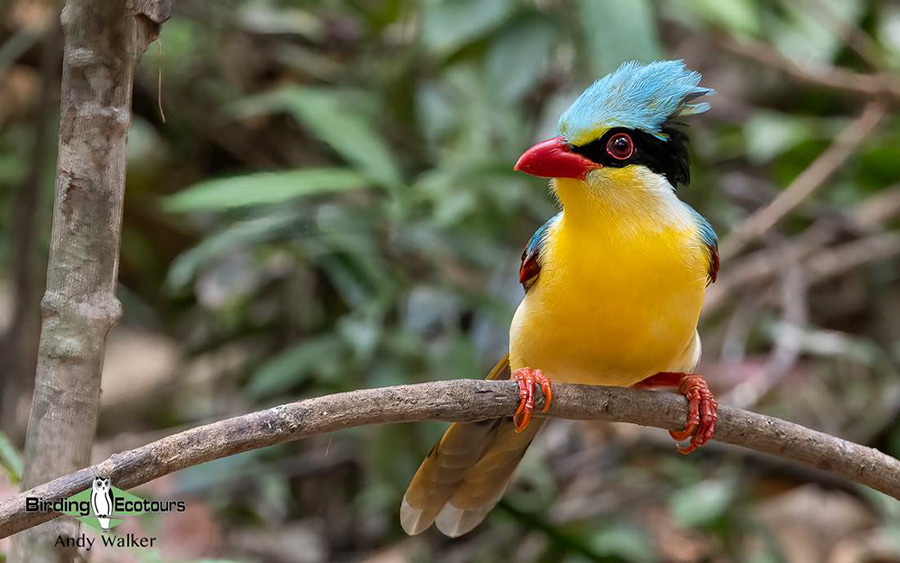
Detailed Itinerary (16 days/15 nights)
Day 1. Arrival in Ho Chi Minh City (Saigon)
After your arrival in Ho Chi Minh City’s Tan Son Nhat International Airport, you will be met by our hotel representatives and transferred the short distance to our hotel. Your time today is at your leisure. We will have a group welcome meal at our hotel in the evening.
Overnight: Ho Chi Minh City
Day 2. Travel from Ho Chi Minh City to Cat Tien National Park
We will depart our hotel early and get some breakfast along the way. We will spend the morning and early afternoon in some bird blinds (bird hides) halfway between Ho Chi Minh City and Cat Tien National Park, where we will hope to find Bar-bellied Pitta, Blue-rumped Pitta, Orange-necked Partridge, Indochinese Green Magpie, and Siamese Fireback, as well as a range of babblers and bulbuls. Although this is the first birding we do of the whole tour, it’s likely to rate as one of the best mornings on the tour, with many highlight species possible.
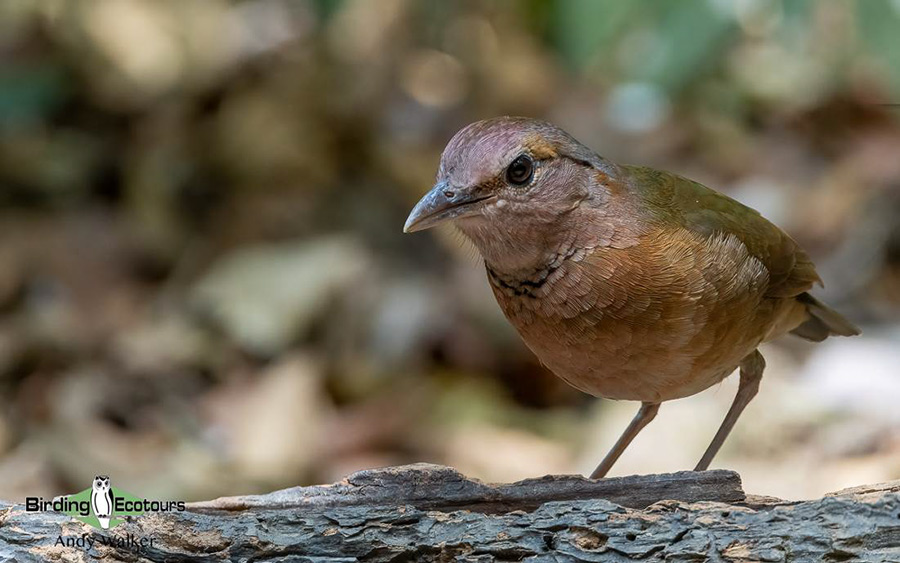
In the afternoon we will complete our journey to Cat Tien National Park, one of the best-protected lowland forest reserves in Vietnam and all of Indochina. We will arrive for our three-night stay in the late afternoon.
Overnight: Cat Tien National Park
Days 3 – 4. Birding at Cat Tien National Park
Cat Tien was the first national park to be established in southern Vietnam. The park has an impressive bird list, with more than 300 species recorded, including several globally threatened species and Indochinese endemics, such as Germain’s Peacock-Pheasant, Orange-necked Partridge (with luck), Siamese Fireback, Green Peafowl, Pale-headed Woodpecker, Bar-bellied Pitta, Blue-rumped Pitta, and Grey-faced Tit-Babbler.
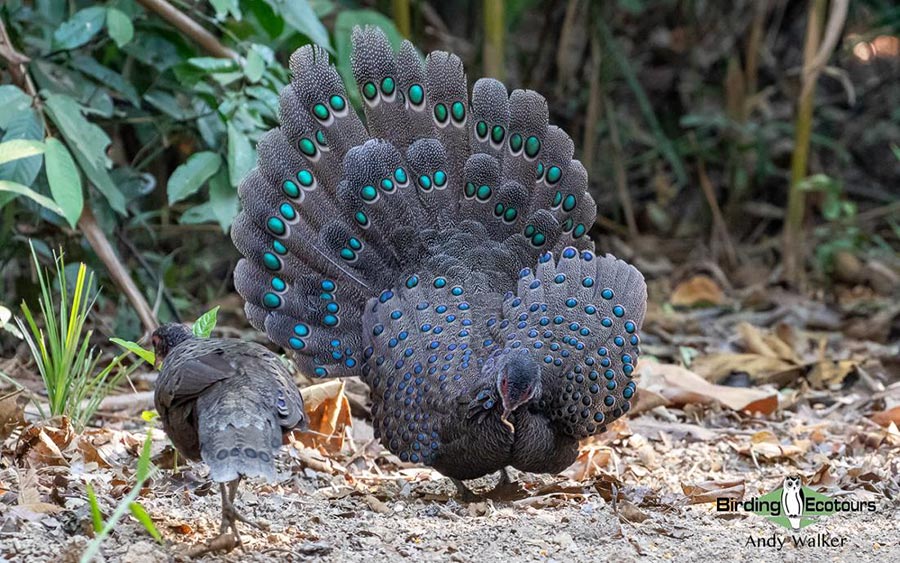
There are literally hundreds of species to look for in the national park and other birds we will hope for during our stay include Ashy-headed Green Pigeon, Orange-breasted Trogon, Banded Broadbill, Black-and-red Broadbill, Dusky Broadbill, Violet Cuckoo, Great Hornbill, Blue-bearded Bee-eater, Banded Kingfisher, White-crested Laughingthrush, White-bellied Woodpecker, Black-and-buff Woodpecker, Great Eared Nightjar, Large-tailed Nightjar, and Blyth’s Frogmouth. In addition to birds, Cat Tien’s forests are an important refuge for Black-shanked Douc Langur, one of the least-known primates in Asia, and Red-cheeked (Yellow-cheeked) Gibbon and we will look for both of these during the tour. The sound of the whooping and screaming gibbons is the sound of the early morning here and is super impressive.
Our time here will offer some great birds and wildlife. The accommodation and food here is basic, but the bird/wildlife sightings make it worthwhile and an essential stop on any birding tour of Vietnam, the national park is that special. The temperatures here climb steeply during the day and so we will have early morning and late afternoon birding sessions, with the middle part of the day spent sitting out the heat.
Overnight (two nights): Cat Tien National Park
Day 5. Cat Tien National Park to Da Lat
We will have a final early morning birding session at Cat Tien National Park before we head north to the Da Lat Plateau during the middle of the day. We will have lunch along the way and will get on with some afternoon birding near Da Lat city after our arrival, where we will look for Red-vented Barbet, Long-tailed Broadbill, and other interesting targets.
Overnight: Da Lat
Days 6 – 7. Birding at Da Lat Plateau
We have two full days to explore the excellent birding sites around Da Lat, and we will focus on Ta Nung Valley, Ho Tuyen Lam (Tuyen Lam Lake), and Bidoup-Nui Ba National Park. We will spend one day utilizing bird blinds (bird hides) for a range of special birds and will birdwatch along forest trails and remote roadsides to mop up our many target birds.
Ta Nung Valley is a small remnant evergreen forest patch, where we will look for the rare and endemic Grey-crowned Crocias, along with White-cheeked Laughingthrush, Blue-winged Minla (a distinct local subspecies known as “Plain Minla”), Rufous-backed Sibia, Black-headed Sibia, Vietnamese Greenfinch, and Black-throated Sunbird (also a very distinct subspecies, known as “Langbian Sunbird”), all of which can be found here.
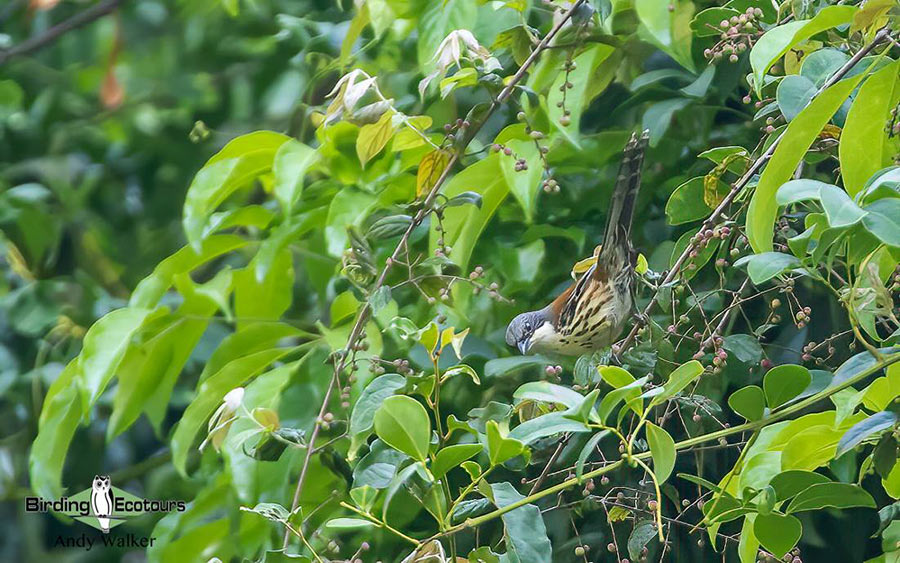
Bidoup-Nui Ba National Park is one of the five largest national parks in Vietnam. Vietnamese endemics found here include Black-crowned Fulvetta, Dalat Bush Warbler, and Collared Laughingthrush. Other target birds in this national park include Rusty-naped Pitta, Yellow-billed Nuthatch, White-spectacled Warbler, Chestnut-crowned Warbler, Kloss’s Leaf Warbler, Mrs. Gould’s (Annam) Sunbird, Spotted Forktail, Black-throated (Grey-crowned) Bushtit, Hume’s Treecreeper, Grey-bellied Tesia, Dark-sided Thrush, Short-tailed Scimitar Babbler, and a very distinctive endemic subspecies of Red (Dalat) Crossbill.
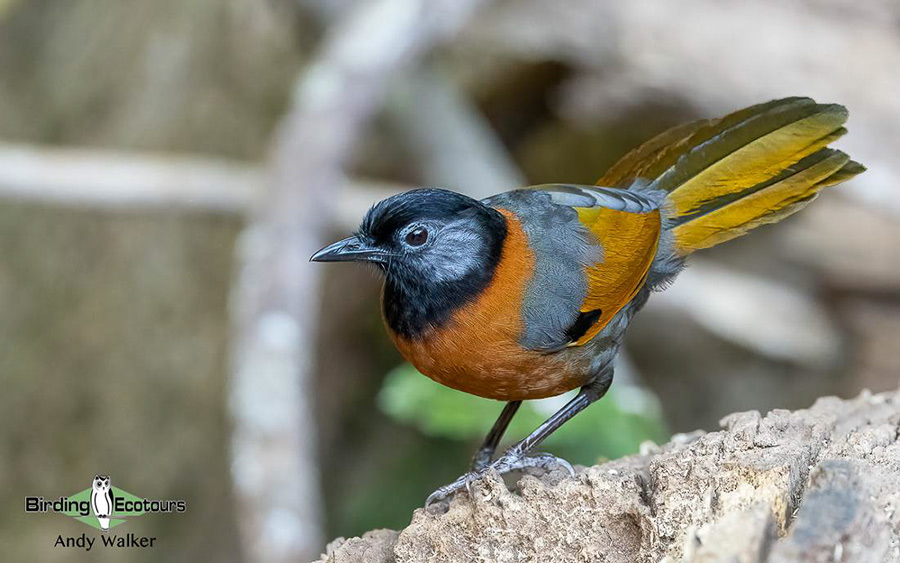
Ho Tuyen Lam (Tuyen Lam Lake) is a man-made lake just outside the town. Vietnamese endemics found here include Vietnamese Cutia, Grey-crowned Crocias, and Vietnamese Greenfinch. Other target birds from this area could include Yellow-billed Nuthatch, Black-headed Sibia, Black-headed Parrotbill, Burmese Shrike, Black-collared Starling, Vinous-breasted Myna, and Slender-billed Oriole, as well as many others.
Overnight (two nights): Da Lat
Day 8. Da Lat Plateau to Di Linh (Birding at Nui San Pass)
We will have a final morning of birding around the Da Lat area. Later we will drive to Nui San Pass (Deo Suoi Lanh near Di Linh town), a forested pass along the road from Di Linh to Phan Thiet. Here we will look for one of the most beautiful birds in the region, Indochinese Green Magpie, along with near-endemic Black-headed Parrotbill. Other possibilities include Silver-breasted Broadbill, Black-hooded Laughingthrush, Red-vented Barbet, Orange-headed Thrush, Black-chinned Yuhina, and Hainan Blue Flycatcher.
Overnight: Di Linh
Day 9. Di Linh (Birding at Nui San Pass)
We will have a morning birding at Nui San Pass area to look for Blue Pitta, and other targets such as Indochinese Green Magpie, Black-headed Parrotbill, Black-hooded Laughingthrush, Red-vented Barbet, Bar-backed Partridge, Collared Babbler, Yellow-vented Green Pigeon, Silver Pheasant, Maroon Oriole, Red-billed Scimitar Babbler, Long-tailed Broadbill, Orange-headed Thrush, Orange-breasted Trogon, and Red-headed Trogon.
In the afternoon we will travel back to Ho Chi Minh City to be well placed for our early morning flight the following day.
Overnight: Ho Chi Minh City.
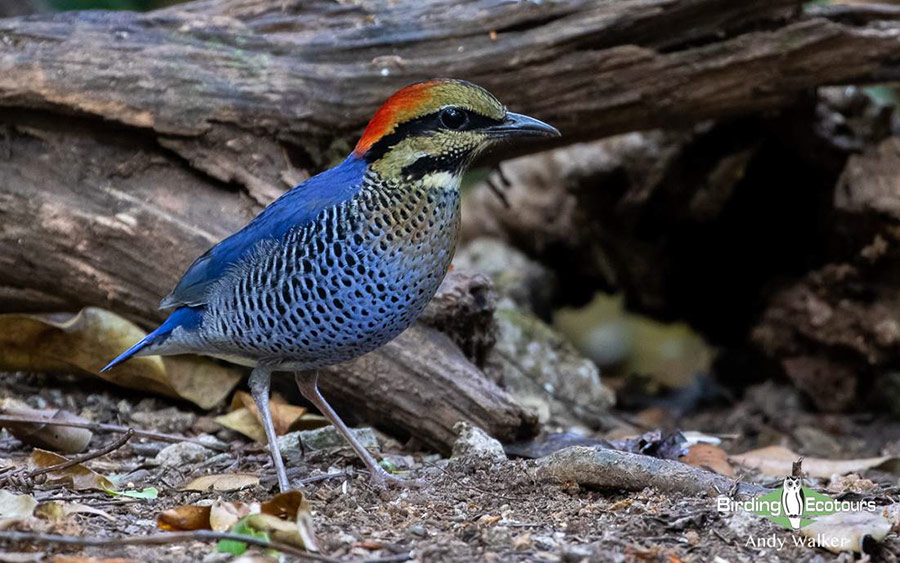
Day 10. Morning flight from Ho Chi Minh City to Pleiku then travel to and birding at Mang Den
We will fly from Ho Chi Minh City’s Tan Son Nhat International Airport to Pleiku airport, Kon Tum Province in Central Vietnam. After arrival at Pleiku we will drive to Mang Den, our first birding stop in Central Vietnam.
We plan on spending the afternoon in a bird blind (bird hide) looking for one of our top targets in the region, the increasingly rare, recently discovered, and endemic Chestnut-eared Laughingthrush. We will also have a back-up opportunity the following day if needed and there are lots of other excellent birds on offer in this area.
Overnight: Mang Den
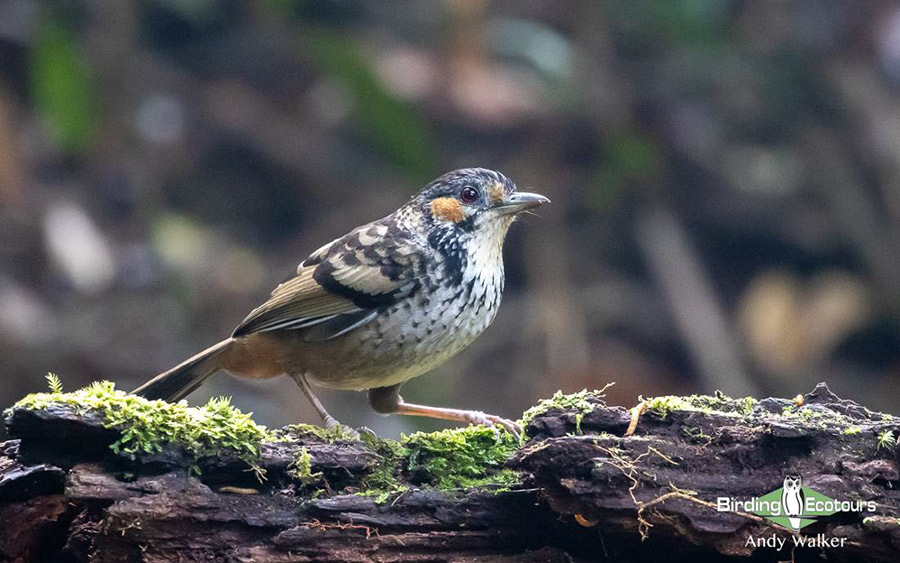
Day 11. Birding at Mang Den
We will spend the morning and afternoon birding sessions near Mang Den, where we will continue our search for Chestnut-eared Laughingthrush, if required. Other specials of Mang Den, of which there are many, include Stripe-breasted Woodpecker, Yellow-billed Nuthatch, Black-hooded Laughingthrush, Short-tailed Scimitar Babbler, Ratchet-tailed Treepie, White-winged Magpie, Rufous-faced Warbler, and Grey-headed Parrotbill.
Overnight: Mang Den
Day 12. Mang Den to Tu Mo Rong
There will be time for some early morning birding at Mang Den looking for more of the above species. In the afternoon we head further north to the rural village of Tu Mo Rong, where we will arrive in the late afternoon at our very basic accommodation for two nights.
Overnight: Tu Mo Rong
Day 13. Birding at Ngoc Linh Nature Reserve
We will spend the majority of the day birding at Ngoc Linh Nature Reserve. This is a really special area, where two species (Golden-winged Laughingthrush and Black-crowned Barwing) were described to science as recently as the 1990s! These new species were originally found by BirdLife International expeditions to the remote Mount Ngoc Linh (2,598 meters / 8,520 feet), which is the highest peak of the Central Highlands. We will of course be looking for these two key species, but plenty of other species are possible, such as Indochinese Fulvetta, Red-tailed Laughingthrush, Green Shrike-babbler, Brown-crowned Scimitar Babbler, Red-tailed Minla, Green Cochoa, Golden-breasted Fulvetta, and Rusty-capped Fulvetta.
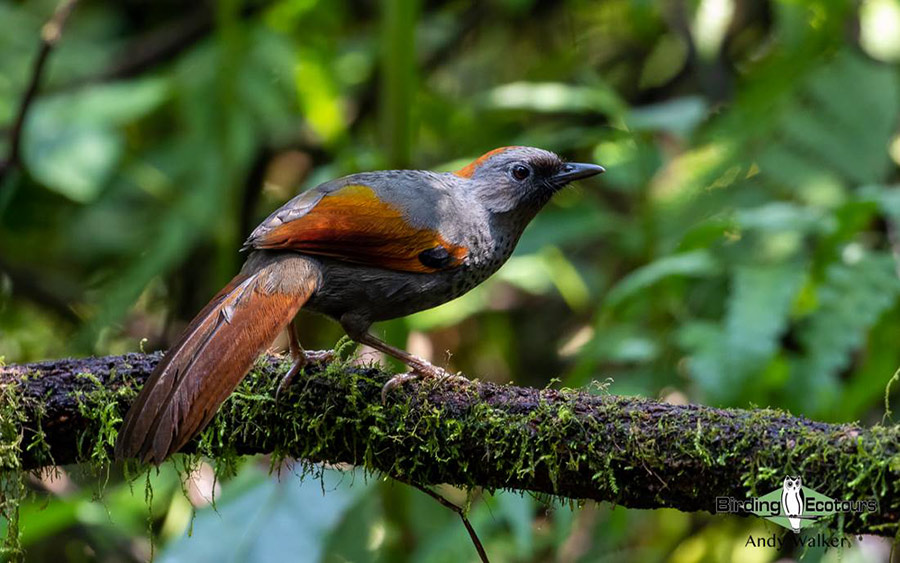
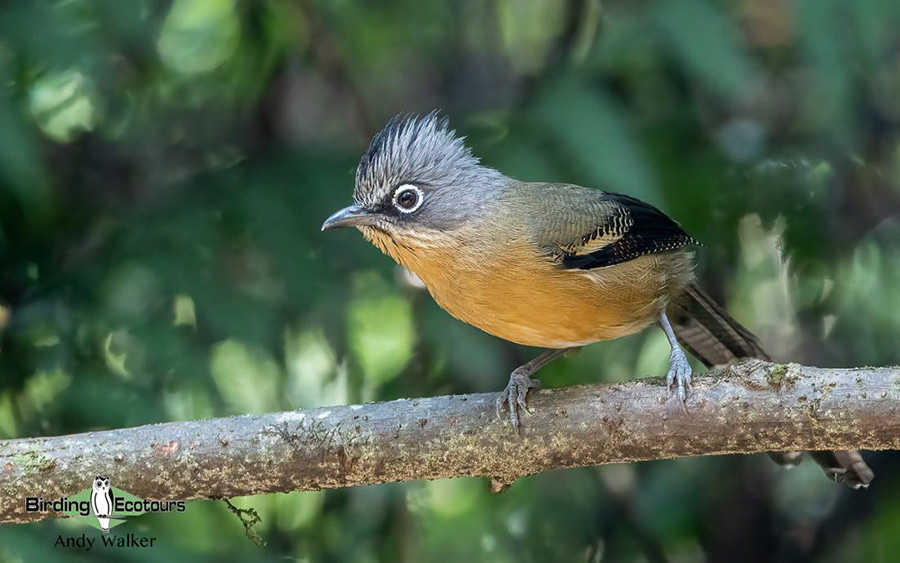
Here we might find an interesting mixed flock or two which could hold interesting species like Kloss’s Leaf Warbler, Grey-cheeked Warbler, Chestnut-crowned Warbler, Yellow-cheeked Tit, Grey-headed Canary-flycatcher, Pygmy Flycatcher, Snowy-browed Flycatcher, Mountain Bulbul, White-browed (formerly Blyth’s) Shrike-babbler, Rufous-winged Fulvetta, Silver-eared Mesia, and Vietnamese Cutia.
During our time in Ngoc Linh Nature Reserve, we will bird forest trails, remote mountain roadsides, and make use of two bird blinds (bird hides) which may offer excellent photo opportunities of some of the most desired species.
Overnight: Tu Mo Rong
Day 14. Tu Mo Rong to Da Nang
Today, is a long travel day as we make our way from Tu Mo Rong in the mountains down to Da Nang, Vietnam’s third largest city, on the coast. We will make a couple of birding stops along the way and stop for breaks and lunch as needed. We might spot some interesting birds during some of these breaks, such as Wire-tailed Swallow and Striated Swallow.
Depending on our timings and how tired we are (and the weather situation), we might have time to visit the nearby Son Tra Nature Reserve, where we will look for the Critically Endangered (The International Union for Conservation of Nature – IUCN) Red-shanked Douc Langur. If we don’t have time this afternoon, we will be covering the site looking for the monkey and other birds the following morning in any case.
Overnight: Da Nang
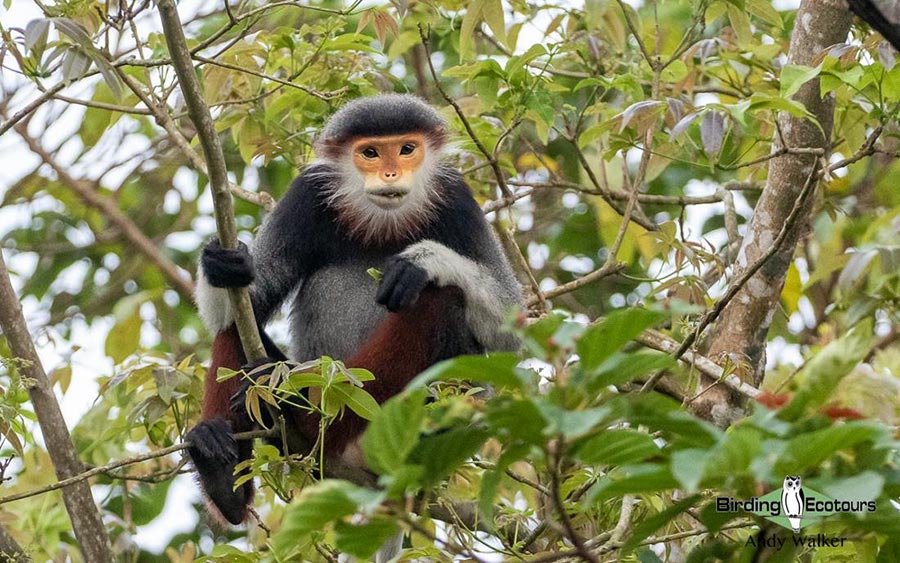
Day 15. Bird and mammal watching on the Son Tra Peninsula, afternoon flight from Da Nang to Ho Chi Minh City
The final morning of the tour will be spent bird and mammal watching at the Son Tra Peninsula. We will look for the rather special Red-shanked Douc Langur as our main target, one highly desired primate. We might find some interesting birds while looking for the monkeys, such as White-crested Laughingthrush, Racket-tailed Treepie, Indochinese Blue Flycatcher, Red-whiskered Bulbul, Ornate Sunbird, and Crimson Sunbird.
After lunch we will fly from Da Nang back to Ho Chi Minh City for the final night of the tour. We will have a final group meal together in the evening and will try and decide on a “bird of the trip”, which we can assure you will be no easy task based on previous experiences here!
Overnight: Ho Chi Minh City
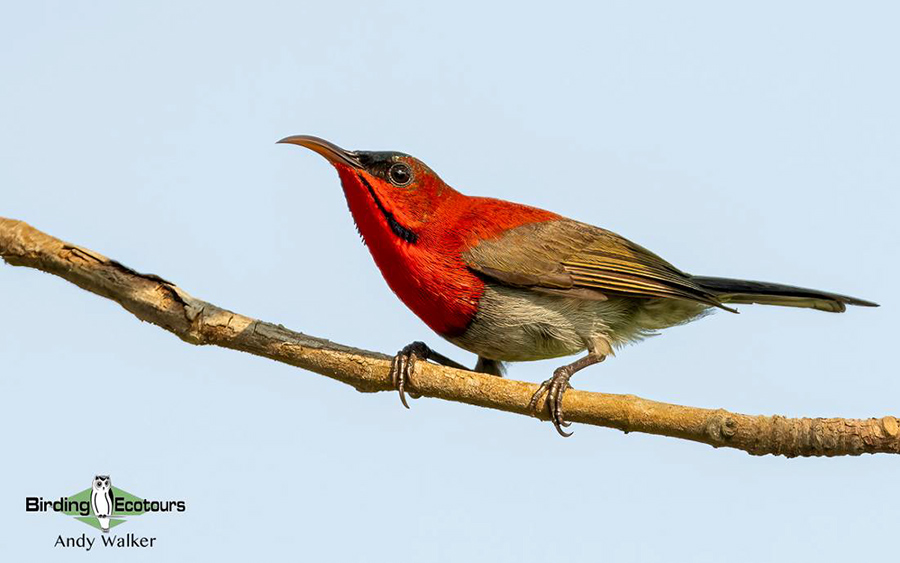
Day 16. Tour concludes with international departure from Ho Chi Minh City
A non-birding day. The tour concludes with your departure from Tan Son Nhat International Airport, Ho Chi Minh City anytime during the day. Please note that breakfast is included today but no other meals are included. Also note that the hotel check-out time is noon, if you intend to stay beyond check-out time additional fees will be payable to the hotel and will depend on their availability situation.
Overnight: Not included
Please note that the itinerary cannot be guaranteed as it is only a rough guide and can be changed (usually slightly) due to factors such as availability of accommodation, updated information on the state of accommodation, roads, or birding sites, the discretion of the guides and other factors. In addition, we sometimes have to use a different international guide from the one advertised due to tour scheduling.
Download ItineraryBirding Southern and Central Vietnam: Endemics and Specials Set Departure Trip Report, March 2024
05 – 20 March 2024
By Andrew Walker
DOWNLOAD TRIP REPORT
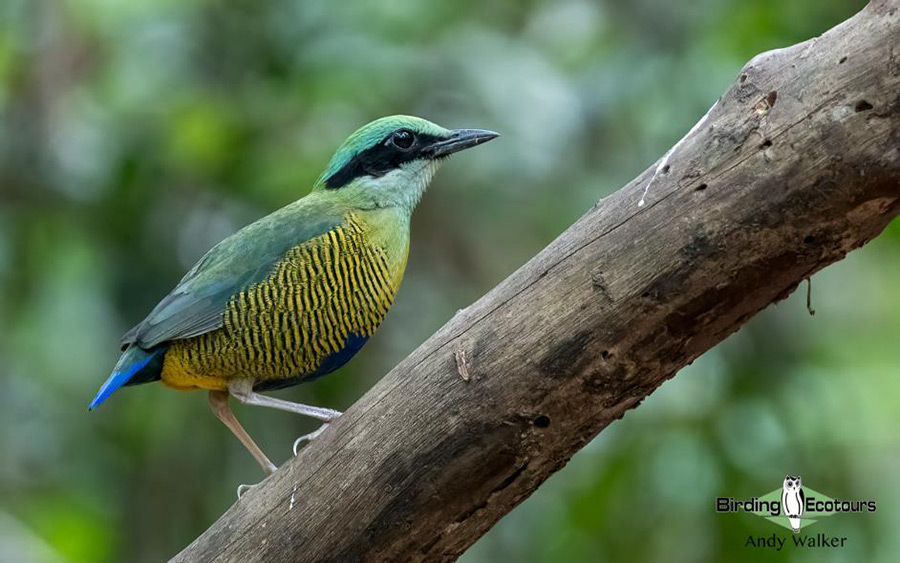
Bar-bellied Pitta gave some great views during the first birding session of our Vietnam birding tour, what a stunning bird!
Overview
This exciting Vietnam birding tour covered the southern and central part of the country and resulted in loads of great birds and some excellent photographic opportunities. The tour started in Ho Chi Minh City (Saigon) on the 5th of March 2024 and ended back there on the 20th of March 2024. We visited some of the top birding destinations in Vietnam, such as Cat Tien National Park, Da Lat, Deo Nui San pass, Mang Den, Ngoc Linh Nature Reserve, and Son Tra Nature Reserve.
We recorded 297 bird species (12 heard only) during the tour, the trip list follows the report. The tour highlights included a long list of endemic and near-endemic birds. Some of the non-passerine highlights included Germain’s Peacock-Pheasant, Green Peafowl, Siamese Fireback, Slaty-legged Crake, Great Eared Nightjar, Hodgson’s Hawk-Cuckoo, Ashy-headed Green Pigeon, Orange-breasted Green Pigeon, Silver-backed Needletail, Black-tailed Gull, Blue-bearded Bee-eater, Banded Kingfisher, Red-vented Barbet, Indochinese Barbet, Necklaced Barbet, Black-and-buff Woodpecker, Collared Falconet, and Red-breasted Parakeet.
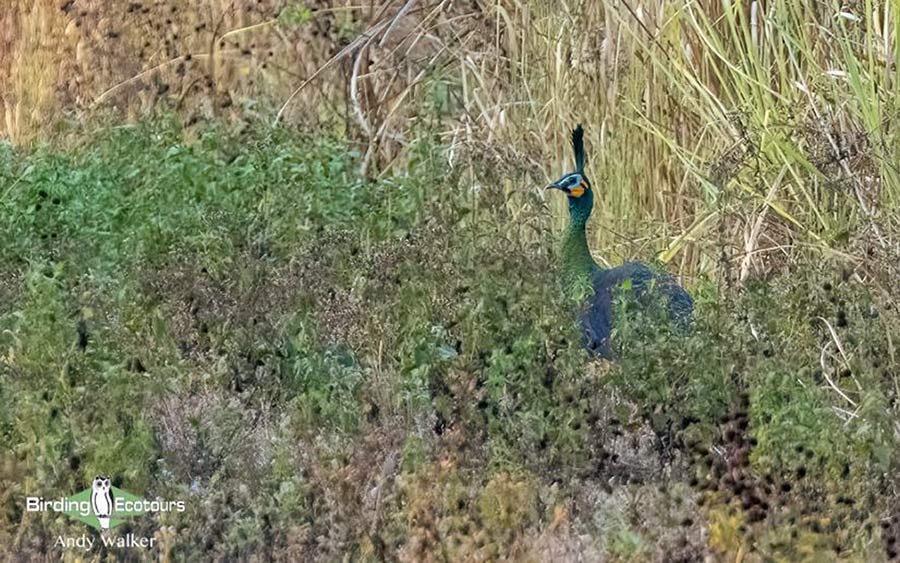
A Green Peafowl was hiding within the vegetation, but the views were still quite good.
Some of the passerine highlights enjoyed on the tour included Bar-bellied Pitta, Blue-rumped Pitta, Rusty-naped Pitta, Blue Pitta, Long-tailed Broadbill, Silver-breasted Broadbill, Dusky Broadbill, Indochinese Green Magpie, Grey-crowned Crocias, Vietnamese Cutia, White-browed (Dalat) Shrike-babbler, Short-tailed Scimitar Babbler, Red-billed Scimitar Babbler, Brown-crowned Scimitar Babbler, Scaly-crowned (Indochinese) Babbler, Japanese Thrush, Collared Laughingthrush, Golden-winged Laughingthrush, Red-tailed Laughingthrush, Black-hooded Laughingthrush, Grey-headed Parrotbill, Black-headed Parrotbill, Black-crowned Fulvetta, Yellow-billed Nuthatch, Green-backed (Langbian) Tit, Black-throated (Grey-crowned) Bushtit, Lesser (Langbian) Shortwing, Mrs. Gould’s (Annam) Sunbird, Black-throated (Langbian) Sunbird, Vietnamese Greenfinch, and Red (Dalat) Crossbill.
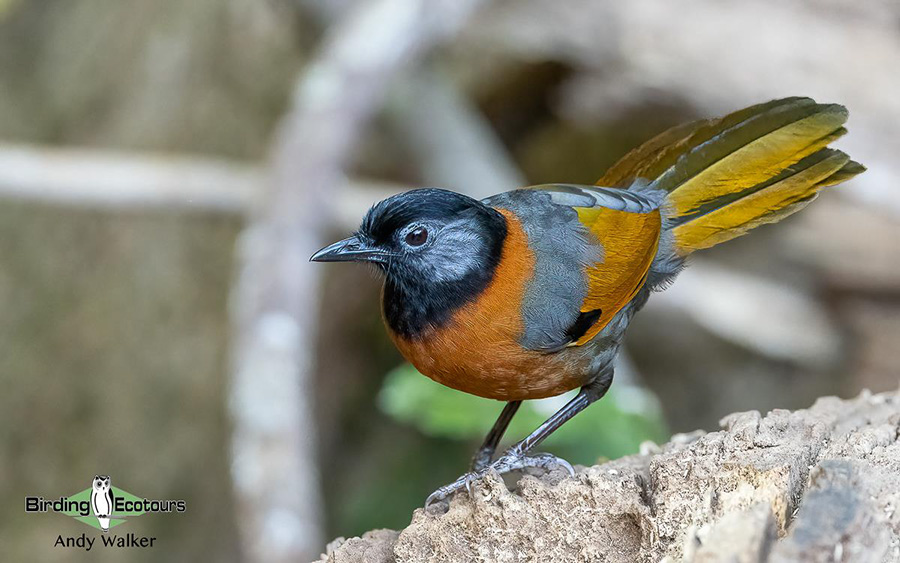
Collared Laughingthrush was a huge Vietnam endemic target that showed well during our tour.
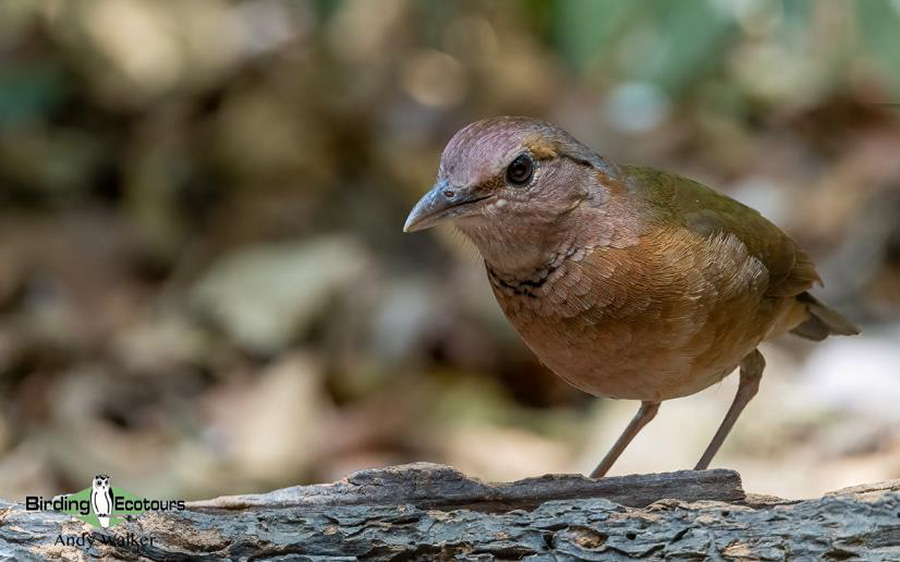
Blue-rumped Pitta gave several excellent views during our Vietnam birding tour.
Detailed Report
Day 1, 5th March 2024. Arrival in Ho Chi Minh City (Saigon)
The group arrived in Ho Chi Minh City, and we met our excellent local guide, Phuc, for a welcome dinner in the evening and discussed, with much excitement, the plans for the next few weeks of birding in Vietnam.
Day 2, 6th March 2024. Travel from Ho Chi Minh City to Cat Tien National Park
We spent the morning and early afternoon birding at Ma Da Forest between Ho Chi Minh City and Cat Tien National Park. It was a great first birding session and the first bird we saw on getting out of the van was a male Banded Kingfisher – what a start! After getting into position in the bird blind (bird hide) we waited in anticipation as to what would come in. We didn’t need to wait too long, with Indochinese Blue Flycatcher coming straight in and they were soon followed by other birds like Bar-bellied Pitta, Blue-rumped Pitta, Laced Woodpecker, Dusky Broadbill, Silver-breasted Broadbill, Abbott’s Babbler, Puff-throated Babbler, Racket-tailed Treepie, and Siberian Blue Robin. A range of tough to see (away from a blind) and gorgeous birds to start our tour off with.
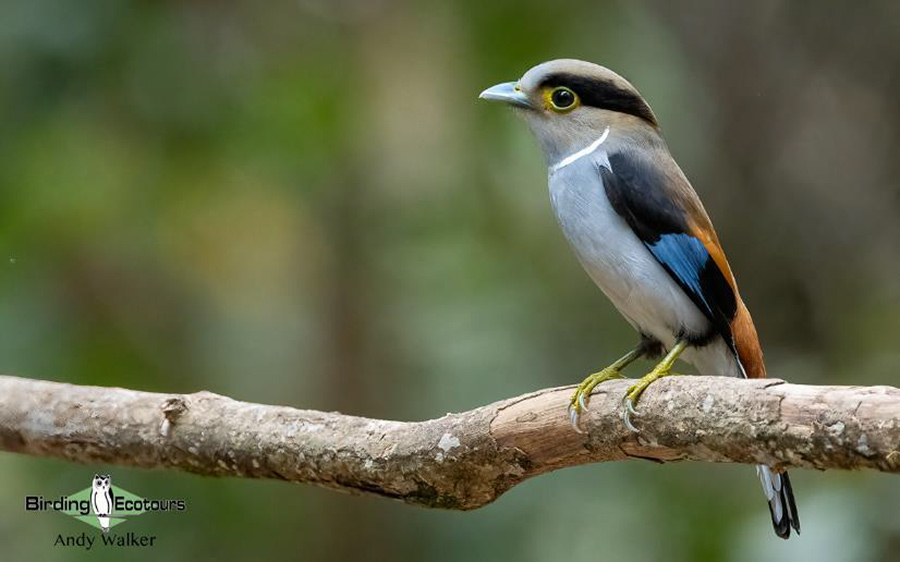
Prolonged views of multiple Silver-breasted Broadbills were the order of the day with birds ever-present at both blinds, giving unparalleled views.
We moved to a different blind, where a different set of birds included Hainan Blue Flycatcher, Black-crested Bulbul, Ochraceous Bulbul, Grey-eyed Bulbul, Scaly-crowned (Indochinese) Babbler, Buff-breasted Babbler, and more of what we’d already seen at the previous blind. After lunch we went back to the second blind site, and not long after were rewarded with views of our main target, a pair of gorgeous Indochinese Green Magpies. After enjoying these sightings, we completed our journey to Cat Tien National Park, where we checked into our accommodation within the national park for the next three nights. A Eurasian Hoopoe on the lawn greeted us as we walked to our rooms.
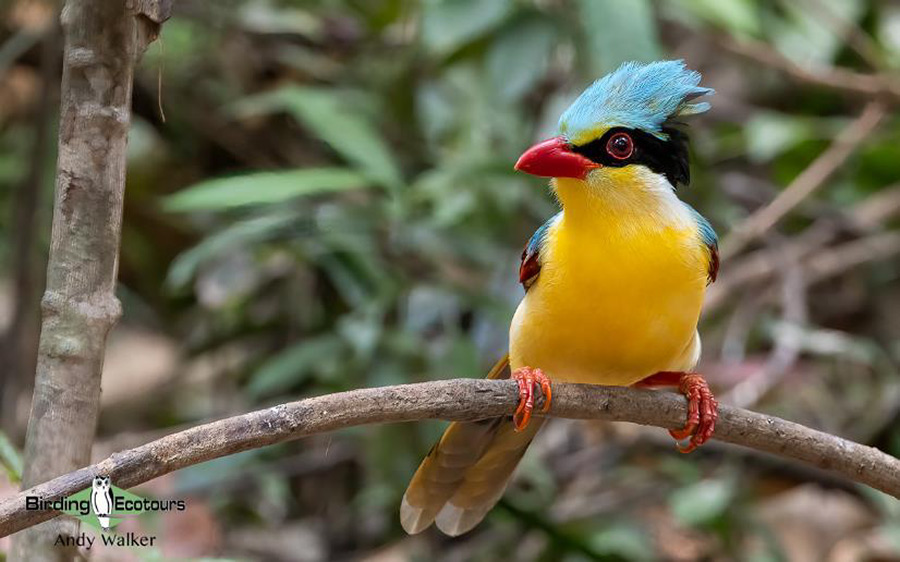
The rather striking Indochinese Green Magpie put on quite a show for us.
Day 3, 7th March 2024. Birding Cat Tien National Park
We spent an enjoyable day birding at Cat Tien National Park. Our morning birding session consisted of a walk along the road parallel to a river, from our accommodation. During our walk we passed through some woodland edge, with pockets of scrub and bamboo and we picked up a lot of great birds. Some of the top highlights from our morning walk included Banded Broadbill, Black-and-red Broadbill, Blue-bearded Bee-eater, Red-breasted Parakeet, Vernal Hanging Parrot, Oriental Pied Hornbill, Banded Kingfisher, Thick-billed Green Pigeon, Green-billed Malkoha, Violet Cuckoo, Banded Bay Cuckoo, Square-tailed Drongo-Cuckoo, Black-hooded Oriole, Great Iora, Swinhoe’s Minivet, White-rumped Shama, Asian Fairy-bluebird, Golden-crested Myna, Ruby-cheeked Sunbird, Blue-winged Leafbird, Golden-fronted Leafbird, and the localized Grey-faced Tit-Babbler. Several animals were seen too, with some excellent views of Red-cheeked (Yellow-cheeked) Gibbons, Cambodian Striped Squirrel, Pallas’s Squirrel, Vietnamese Blue Crested Lizard, Spotted Flying Dragon, and a briefly seen (by some) unidentified snake.
In the afternoon we visited another blind, this time about a 25-minute drive from our accommodation within the national park. It was a busy hide with some great birds and mammals in attendance. Two of the stars of the show were the pair of Bar-bellied Pittas that stayed around for quite a while (though often in the undergrowth trying to remain hidden), and our main target, Germain’s Peacock-Pheasant. A beautiful bird walked into view and showed well for some time. The supporting cast included Red Junglefowl, Siberian Blue Robin, White-rumped Shama, Grey-faced Tit-Babbler, and more. One of the surprises of the afternoon was the Slaty-legged Crake that spent some time visiting the blind, giving excellent views of this tough bird. Mammals at the blind included Pallas’s Squirrel, Northern Treeshrew, and Northern Smooth-tailed Treeshrew. As we drove back to our accommodation in the late afternoon, we found the gorgeous Black-shanked Douc Langur, Northern Pig-tailed Macaque, and Long-tailed Macaque. At dusk we took a walk near our accommodation where we found a pair of Great Eared Nightjars before we had our dinner. An excellent ending to a bird-filled day of birding at Cat Tien National Park.
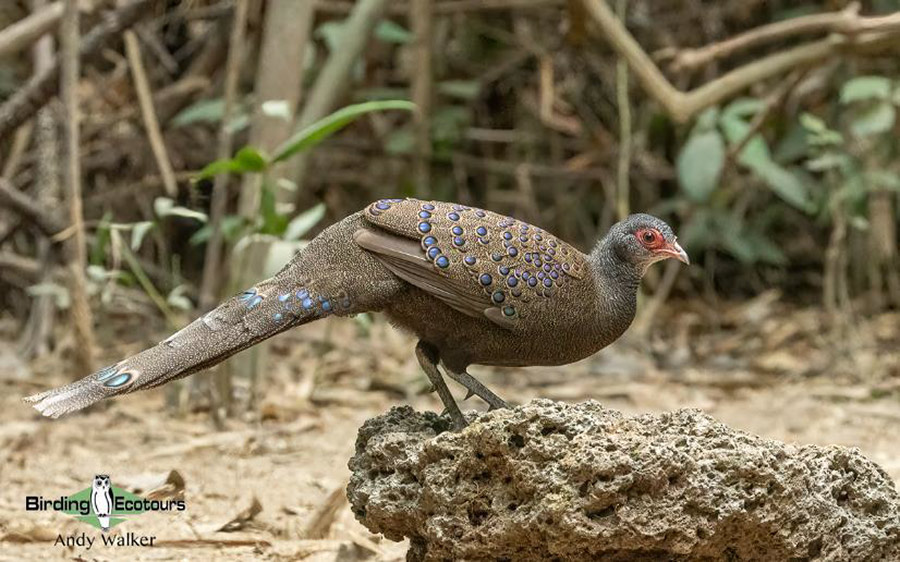
The localized Germain’s Peacock-Pheasant was the main target during our afternoon birding at Cat Tien National Park, and we got some great views.
Day 4, 8th March 2024. Birding Cat Tien National Park
We enjoyed another morning birding at Cat Tien National Park. We headed over to the same area we’d spent the previous afternoon and soon started picking up some great birds, such as Ashy-headed Green Pigeon, Thick-billed Green Pigeon, Vernal Hanging Parrot, Black-and-buff Woodpecker, Heart-spotted Woodpecker, White-bellied Woodpecker, Greater Flameback, and Violet Cuckoo.
We again went into a blind, where we got excellent views of a pair of Bar-bellied Pittas, along with other species, including Slaty-legged Crake, Green-legged Partridge, Red Junglefowl (including a stunning male), Siberian Blue Robin, and a range of babblers and bulbuls.
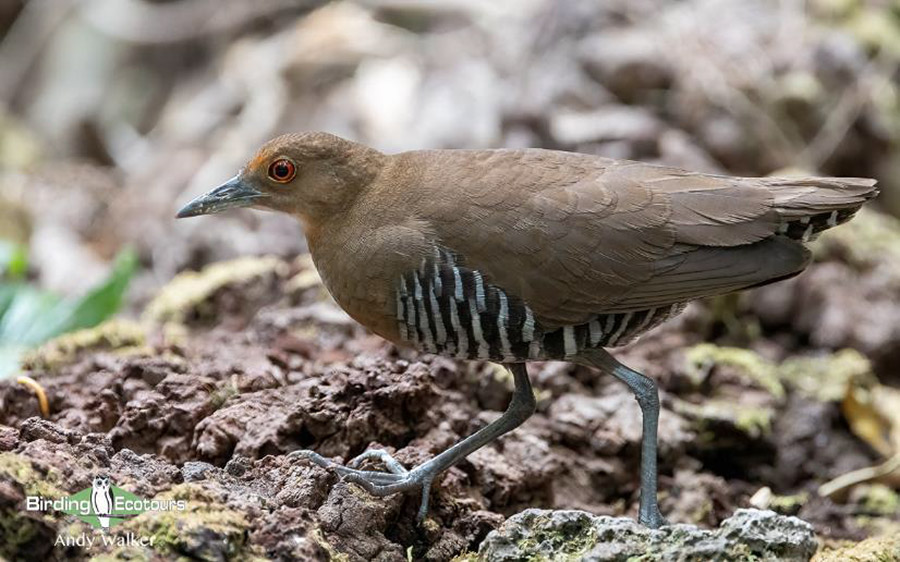
This Slaty-legged Crake gave very good and prolonged views.
During the afternoon we drove a road back and forth looking through some more open habitat and it provided us with the opportunity for a few different birds. Our top target was Green Peafowl, and we got some good views of one of these in a field. During this drive we also found Siamese Fireback, Red Junglefowl, Orange-breasted Green Pigeon, Red Collared Dove, Lesser Coucal, Lineated Barbet, Black-headed Bulbul, Sooty-headed Bulbul, White-throated Kingfisher, Brown-backed Needletail, and Brown Shrike. As we headed back to our accommodation, we noted Sambar and Common Palm Civet.
Day 5, 9th March 2024. Cat Tien National Park to Da Lat
Prior to breakfast we had Brown Boobook, Asian Barred Owl, and Great Eared Nightjars calling and then we enjoyed a final morning birding in Cat Tien National Park, where we visited a different section of the park to where we had birded previously. It was a beautiful area of forest with some very impressive, huge trees. The birding was also good, and we again saw several woodpeckers, including White-browed Piculet, Greater Flameback, and Grey-headed (Black-naped) Woodpecker, along with other goodies such as Siamese Fireback, Golden-crested Myna, Oriental Dollarbird, Red-breasted Parakeet, Vernal Hanging Parrot, Asian Fairy-bluebird, Van Hasselt’s Sunbird, Crimson Sunbird, and Forest Wagtail. Shikra and Crested Goshawk were both seen overhead, the latter giving a display flight, as were Silver-backed Needletails, Asian Palm Swifts, and Germain’s Swiftlets. One of the most bizarre sightings of the day was several gatherings of flatid planthopper nymphs – a remarkable sight.
After leaving Cat Tien behind we drove across to Da Lat, our base for the next three nights.
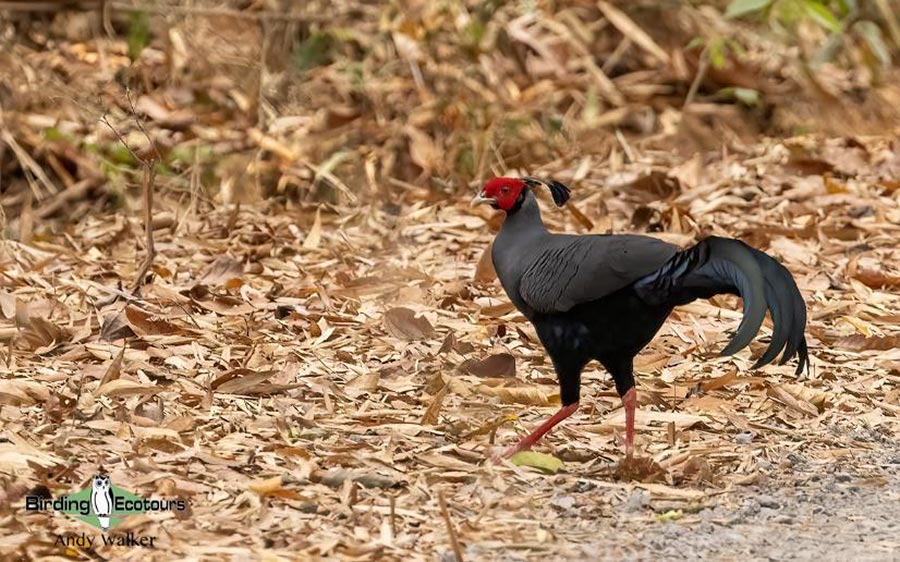
We signed off from our birding at Cat Tien National Park with a great look at Siamese Fireback.
Day 6, 10th March 2024. Birding Da Lat Plateau
We enjoyed a wonderful day birding the Da Lat Plateau where numerous Vietnamese endemic birds and regionally endemic species and subspecies were found. Most of the birds recorded during the day gave superb views, many at very close range. We did some roadside birding and visited some blinds to allow us to look for some secretive birds.
Our first blind visit yielded one of the area’s top birds, the Endangered (BirdLife International) endemic Collared Laughingthrush. We had some very close views of this stunning species (see the photo in trip report summary above). The fine supporting cast was made up of Large Niltava, White-tailed Robin, Verditer Flycatcher, Little Pied Flycatcher, Snowy-browed Flycatcher, and White-browed Scimitar Babbler, all of which showed equally well. As we walked along a few sections of mountain roads, we found Vietnamese Cutia, White-browed (Dalat) Shrike-babbler, Black-headed Parrotbill, Green-backed (Langbian) Tit, Long-tailed (Annam) Minivet, and Kloss’s Leaf Warbler.
In the middle of the morning, we visited a second blind, and once again were in awe of the birds and the views we were getting. Highlights here included White-cheeked Laughingthrush, Grey-bellied Tesia, White-throated Fantail, Grey-throated Babbler, Black-crowned Fulvetta, Short-tailed Scimitar Babbler, Mountain Fulvetta, Black-headed (White-spectacled) Sibia, Dark-sided Thrush, Lesser (Langbian) Shortwing, and Mugimaki Flycatcher.
Over lunch and a bit of a rest, we found Red (Dalat) Crossbill, Vietnamese Greenfinch, Mrs. Gould’s (Annam) Sunbird, Indian Cuckoo, Flavescent Bulbul, and Grey Bush Chat. After the break we went back into a blind for the final birding session of the day, and it was a great one. Highlights were many and included the top trio of Rufous-throated Partridge, Rusty-naped Pitta, and Blue Pitta. As well as many of the birds already mentioned above!
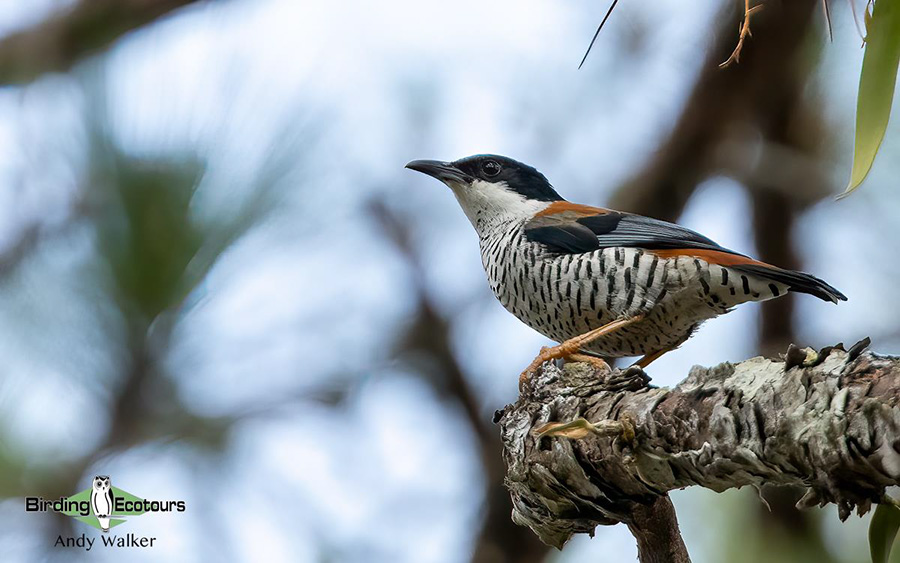
We had some good looks at Vietnamese Cutia while birding at Da Lat.
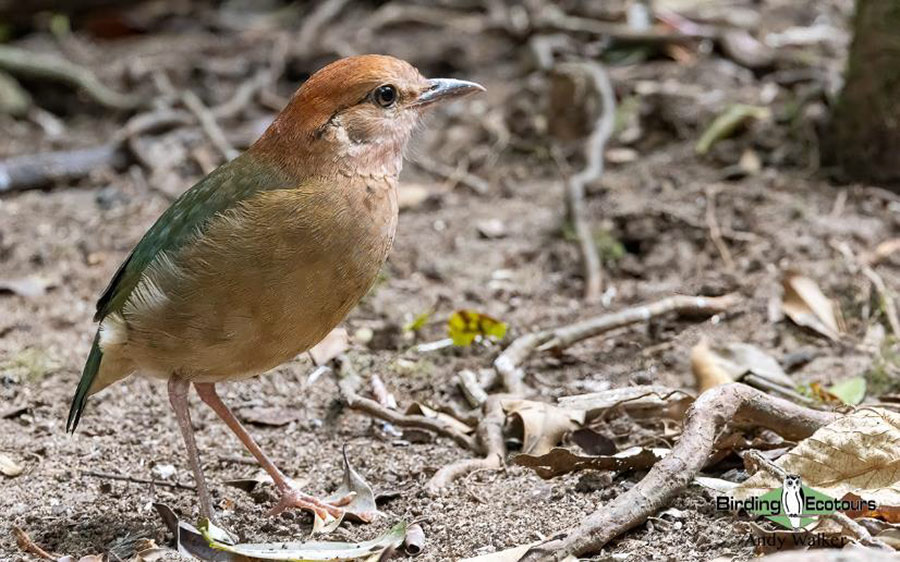
A rather shy Rusty-naped Pitta eventually came out into an open area and showed well.
Day 7, 11th March 2024. Birding Da Lat Plateau
We spent the morning birding at a couple of sites in the vicinity of Da Lat city. The main target at our first site, a garden with remnant forest patches, was Grey-crowned Crocias, which we did see a few times, but it didn’t come close. While we were birding around the garden and looking for the crocias, we picked up Silver-eared Mesia, Blue-winged (Plain) Minla, Rufous-backed Sibia, Black-headed (White-spectacled) Sibia, White-cheeked Laughingthrush, Vietnamese Greenfinch, Indochinese Barbet, Hill Prinia, Green-backed (Langbian) Tit, Black-throated (Grey-crowned) Bushtit, Mrs. Gould’s (Annam) Sunbird, and Black-throated (Langbian) Sunbird.
We moved locations to another couple of forest patches, where we found Burmese Shrike, Chestnut-vented Nuthatch, Indochinese Cuckooshrike, and Black Bulbul. Three Ospreys were flying over a nearby lake, which also contained Little Grebe, Common Moorhen, and Little Cormorant. Vegetation around the lakeshore held Yellow Bittern, Chinese Pond Heron, and Little Egret.
We took an afternoon walk on the edge of Da Lat city, where we had brief views of a pair of Long-tailed Broadbills as well as some very nice looks at Necklaced Barbet. We also saw Barred Cuckoo-Dove, Mountain Imperial Pigeon, Banded Bay Cuckoo, Black-throated (Grey-crowned) Bushtit, and Black Bulbul. As dusk came, we changed locations and had House Swift and Plain-backed Sparrow just before it got dark, and immediately after found several Grey Nightjars, a gorgeous rufous morph Oriental Scops Owl, and a Large-tailed Nightjar.
Day 8, 12th March 2024. Da Lat Plateau to Di Linh (Birding at Deo Nui San Pass)
We left Da Lat after breakfast and drove to Di Linh. We arrived in the middle of the morning and went straight to a bird blind, where we saw more great birds. One of the most abundant species present at the blind was Orange-headed Thrush, with two subspecies (and a hybrid between those noted). A pair of Streaked (Annam) Wren-Babblers showed very nicely and they were joined by a male Hainan Blue Flycatcher, Grey-throated Babbler, and White-throated Rock Thrush. It all got a bit chaotic when a mixed-species flock passed through our viewing area. The flock contained Red-billed Scimitar Babbler, Black-chinned Yuhina, Black-headed Parrotbill, Red-headed Trogon, Speckled Piculet, and White-bellied Erpornis. A vocal Alström’s Warbler was also hanging around but tended to remain in the undergrowth.
After a bite to eat we went straight into a different blind from our morning one, hoping for some more excitement, and wow, did we get that! On arrival at the blind, we were greeted by the sight of around a dozen Orange-headed Thrushes all out in the open (again both subspecies were present), with a female-type Siberian Thrush thrown in for good measure. As we got into place the birds started coming in and over the course of the next few hours’ we were treated to an excellent showing of Orange-headed Thrushes, several Siberian Thrushes (including several male birds), and rarest of all, at least two Japanese Thrushes, including one stunning male bird. Lots of other birds were present too, such as Blue-rumped Pitta, Silver-breasted Broadbill, Blue-and-white Flycatcher, Hainan Blue Flycatcher, Mugimaki Flycatcher, Greater Racket-tailed Drongo, Lesser Racket-tailed Drongo, Ashy (Brown-backed) Bulbul, Indian White-eye, Velvet-fronted Nuthatch, and many of the birds seen at the previous blind earlier in the day.
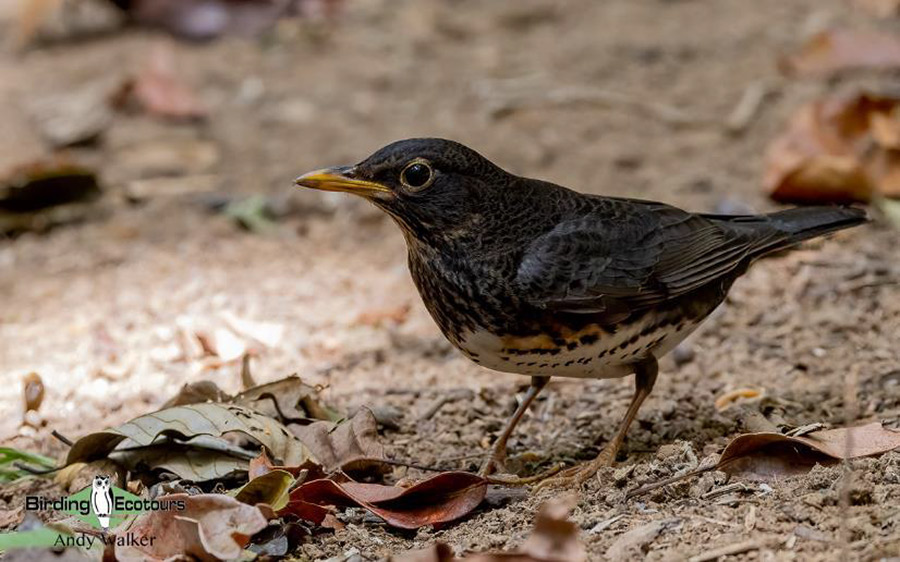
Japanese Thrush is a rare migrant to southern Vietnam, so we were very pleased to find two birds while birding at Di Linh.
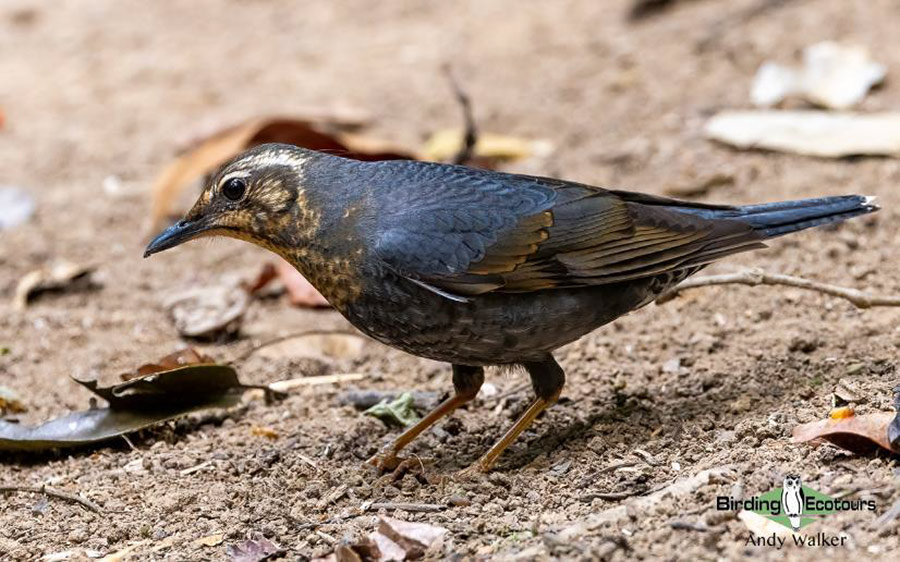
This molting male Siberian Thrush was coming into breeding plumage.
Leaving the blind, we walked a short stretch of road, where we saw Black Eagle, Grey-faced Buzzard, Bay Woodpecker, Red-vented Barbet, Scarlet Minivet, Black Bulbul, Dusky Crag Martin, Red-rumped Swallow, and Asian House Martin. As we drove to our hotel for the night, a couple of stops gave us sightings of Annam Prinia, Black-winged Kite, Black-collared Starling, and Eurasian (White-faced) Jay.
Day 9, 13th March 2024. Di Linh (Birding at Deo Nui San pass)
We had a morning birding back in the forest at Deo Nui San pass getting repeated good views of some rather nice birds. A nesting pair of Long-tailed Broadbills remained quite shy, but we had some good scope views to prevent disturbing them. We visited another bird blind, where we enjoyed sightings of Orange-headed Thrushes, Red-billed Scimitar Babbler, White-browed Scimitar Babbler, Streaked (Annam) Wren-Babbler, and many birds seen previously. As we were preparing to leave the blind a pair of Indochinese Green Magpies also flew in above us.
A brief stop at an area of rice paddies provided a change of scenery and we saw Burmese Shrike, Chestnut-tailed Starling, Coppersmith Barbet, and Paddyfield Pipit. After lunch we drove back to Ho Chi Minh City for the night, in preparation for our flight the following day.
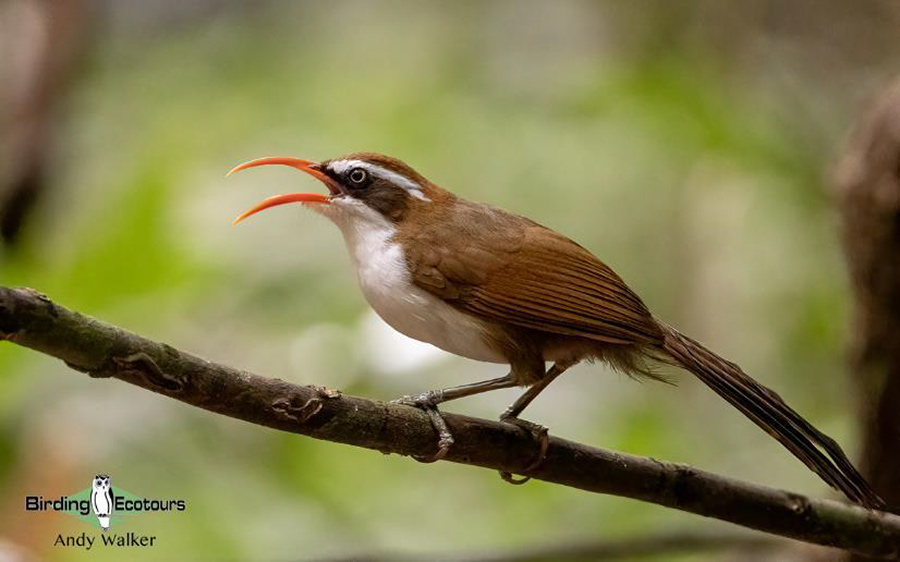
Red-billed Scimitar Babbler showed well during the Vietnam birding tour.
Day 10, 14th March 2024. Ho Chi Minh City to Pleiku then travel to Mang Den
We took a morning flight from Ho Chi Minh City to Pleiku in central Vietnam. After our arrival we drove north to Mang Den where we checked into our hotel for the next two nights. An afternoon birding session gave us a few new birds, including brief views, for some, of Black-hooded Laughingthrush, a stunning pair of White-gorgeted Flycatchers, vocal Hodgson’s Hawk-Cuckoo, Short-billed Minivet, Yellow-billed Nuthatch, Blue-and-white Flycatcher, and Black-throated (Grey-crowned) Bushtit.
Day 11, 15th March 2024. Birding at Mang Den
We spent the morning birding in the forest around Mang Den. It was hotter than usual, and activity was lower than expected, but we managed to find a few new birds for the trip such as Grey-headed Parrotbill, Golden Babbler, Clicking Shrike-babbler, Rufous-faced Warbler, Grey-chinned Minivet, Pale Blue Flycatcher, and Mountain Bulbul. Some of the group got brief views of a male Red-headed Trogon and a mobile flock of Black-hooded Laughingthrushes. Plenty of common and more widespread species were seen too, such as White-bellied Erpornis, Black Bulbul, and Mountain Fulvetta. Ratchet-tailed Treepie and Collared Babbler were both heard, but unfortunately not seen.
In the afternoon we took a walk around a different area of forest from our morning walk. We had a raucous party of Black-hooded Laughingthrushes that kept us entertained for a while as we tried to get good views of them, but they were very active and so views were close but fleeting. A pair of Red-headed Trogons gave brief views to some folks again, but they seemed very shy. An Indochinese Green Magpie came in with the noisy laughingthrushes but was typically furtive, despite being loud! Rufous-faced Warbler, Maroon Oriole, Bay Woodpecker, (Northern) Mountain Bulbul, Golden Babbler, Grey-chinned Minivet, and Black-throated Sunbird were all also seen.
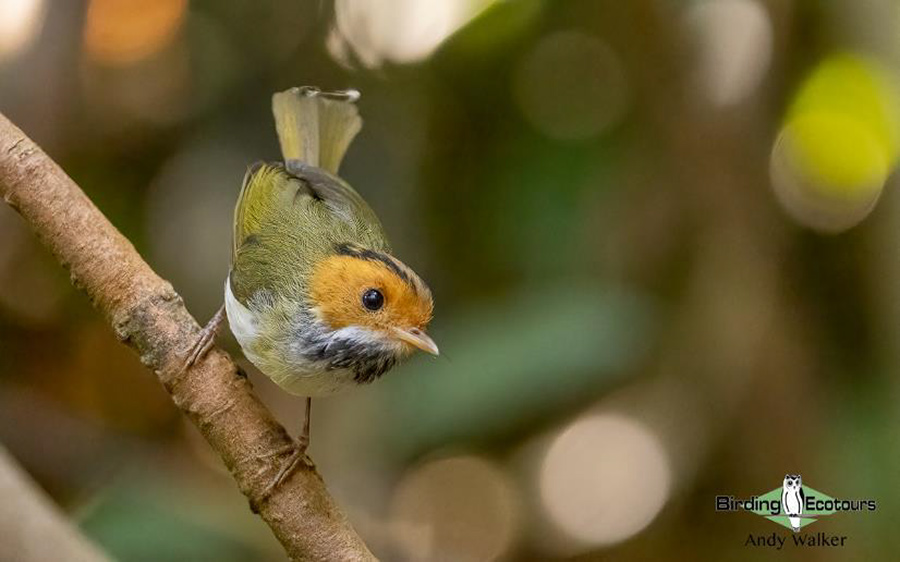
This rather cute Rufous-faced Warbler gave some very close views while birding at Mang Den.
Day 12, 16th March 2024. Birding Mang Den and travel to Tu Mo Rong
We spent a final morning trying to find some new birds around Mang Den, and we did find a couple, such as very brief Orange-bellied (Greyish-crowned) Leafbird and (Annam) Sultan Tit, along with Puff-throated Bulbul. One of the best birds was a showy Streaked (Tonkin) Wren-Babbler that gave close and lengthy views, nice after seeing the “Annam” version earlier in the tour. We also had an extremely confiding Rufous-faced Warbler. We enjoyed further sightings of Grey-headed Parrotbill, Grey-faced Buzzard, Black-hooded Laughingthrush, and a few other species previously seen.
After lunch we drove to Tu Mo Rong, our basic accommodation (and the only option in this part of the country) for our remote birding tomorrow. We stopped at some rice paddies in the late afternoon, where we found several open-country species, including a few new trip birds like Oriental Turtle Dove, Dusky Warbler, and Scaly-breasted Munia, along with a gorgeous breeding-plumage Chinese Pond Heron.
Day 13, 17th March 2024. Birding Ngoc Linh Nature Reserve
We spent the full day birding at Ngoc Linh Nature Reserve with most of this time spent sitting in two blinds waiting for our key species to show. Our time in the blinds gave us excellent sightings of several great species, such as Black-crowned Barwing, Brown-crowned Scimitar Babbler, Rusty-capped Fulvetta, Rufous-winged Fulvetta, Black-headed (Brownish-backed) Sibia, Rufous-capped Babbler, Rufous-gorgeted Flycatcher, Large Niltava, and Eyebrowed Thrush, along with a brief view of Red-tailed Laughingthrush and (eventually) an excellent look at the highly sought after Golden-winged Laughingthrush, which was definitely worth the nervous wait we had!
Later in the day we found a nice mixed flock containing Yellow-cheeked Tit, White-spectacled Warbler, Grey-cheeked Warbler, Chestnut-crowned Warbler, Red-tailed Minla, Green-tailed Sunbird, and Red-headed Trogon. It was a very enjoyable day of birding.
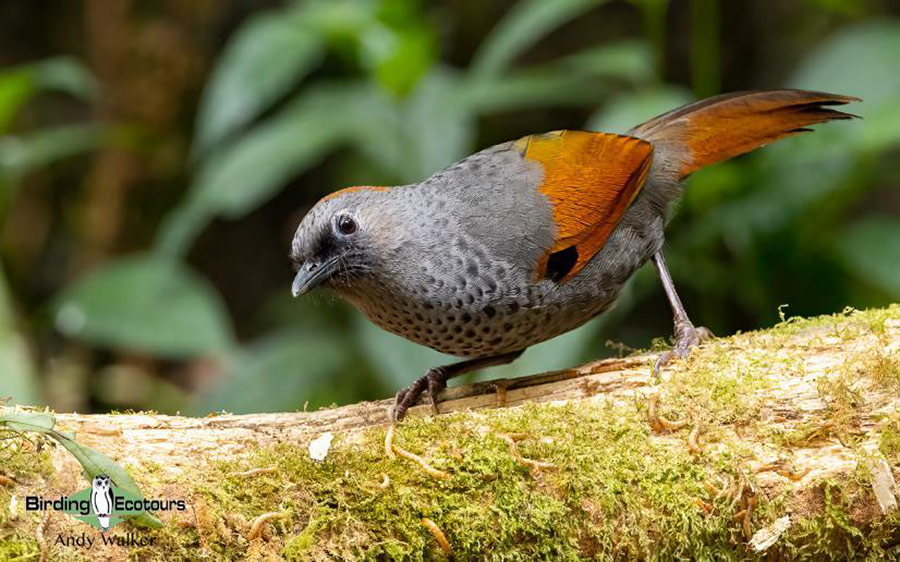
The top target for the day was the near-endemic Golden-winged Laughingthrush. Ngoc Linh Nature Reserve offers the only realistic chance of seeing this bird anywhere in the world and we were delighted with the views we got.

Ngoc Linh Nature Reserve also offers one of the best opportunities to connect with the near-endemic Black-crowned Barwing and we enjoyed excellent views of a pair of birds.
Day 14, 18th March 2024. Tu Mo Rong to Da Nang and mammal watching on the Son Tra Peninsula
Essentially a long travel day as we made our way from remote Tu Mo Rong to the bustling city and bright lights of Da Nang. We left Tu Mo Rong after our early breakfast and made a few birding stops along the way to our destination. The first two stops were on high elevation forested roads, before we dropped down from the mountains. At our stops we found Mountain Imperial Pigeon, Hodgson’s Hawk-Cuckoo, Black Eagle, Necklaced Barbet, White-throated Fantail, Lesser Racket-tailed Drongo, Yellow-cheeked Tit, Black Bulbul, Chestnut-crowned Warbler, Silver-eared Mesia, Yellow-billed Nuthatch, Pale Blue Flycatcher, Mrs. Gould’s (Scarlet-breasted) Sunbird, Black-throated Sunbird, and Green-tailed Sunbird.
Dropping in elevation we noted Blue Rock Thrush, Striated Swallow, Long-tailed Shrike, and Crimson Sunbird along the road. Then, at a coffee stop at a river, we found Wire-tailed Swallow, Plaintive Cuckoo, Greater Coucal, Common Sandpiper, Wood Sandpiper, Plain Prinia, Ornate Sunbird, White Wagtail, and Paddyfield Pipit. Nearby rice paddies held Amur Stonechat, along with Chinese Pond Heron, Eastern Cattle Egret, Little Egret, Medium Egret, and Great Egret.
We arrived in Da Nang in the middle of the afternoon and once things had cooled down a little, we headed over to Son Tra Nature Reserve on the edge of the city. Here we searched for and found our main target – Red-shanked Douc Langur. We saw a family group of langurs, which allowed great views. We also saw several Rhesus Macaques that showed very well too, though they were not quite as spectacular!
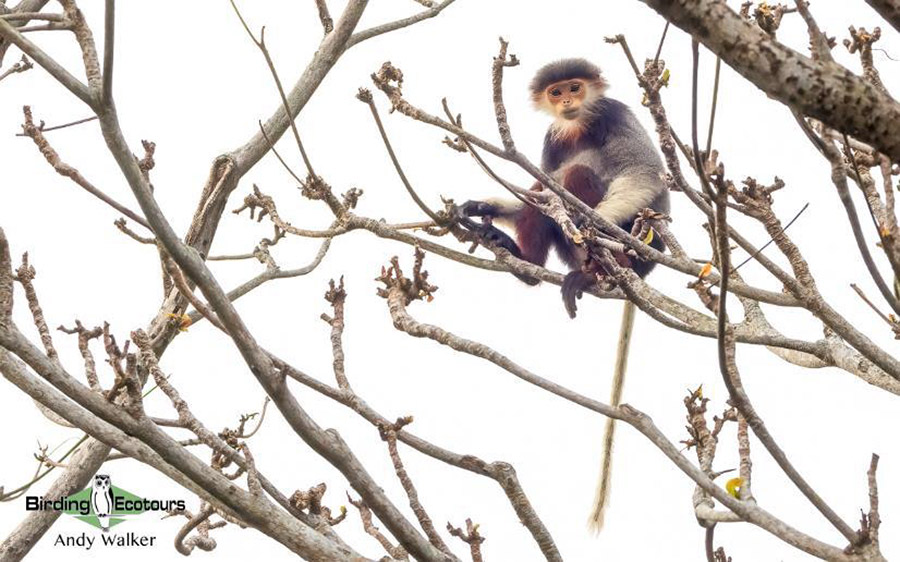
The rare Red-shanked Douc Langur was a highlight of our time on the Son Tra Peninsula, and the main reason for our visit.
Day 15, 19th March 2024. Bird and mammal watching on Son Tra Peninsula, flight from Da Nang to Ho Chi Minh City
We spent the final morning of the tour undertaking some pre-breakfast birding along the coast of the Son Tra Peninsula, where we added a few final trip birds. The best of the new birds was a Black-tailed Gull on the beach, which was getting hassled nonstop by a Pacific Reef Heron. Also, along the beach, we found White-breasted Waterhen, Common Sandpiper, Common Kingfisher, Red-whiskered Bulbul, Dusky Warbler, White-shouldered Starling, and excitingly, a hunting Peregrine Falcon, which may have actually caught the Common Sandpiper! While in the area we checked out some forest which held a family group of Red-shanked Douc Langurs, so we had a further look at this gorgeous monkey.
In the afternoon we boarded our flight back to Ho Chi Minh City for the final night and our final group dinner of the tour. We tried to pick the “bird of the trip”, but it wasn’t an easy task given the many high-quality birds we had seen over the previous two weeks. However, Golden-winged Laughingthrush won the award given its rarity value, interesting history, stunning good looks, and the effort we put in to seeing one (maintaining the faith one would come in even when it wasn’t looking very likely!), in such a beautiful forest.
Day 16, 20th March 2024. Departure day from Ho Chi Minh City
Everyone departed from Ho Chi Minh at their leisure as this highly successful Vietnam birding tour concluded.
Bird List – Following IOC (14.1)
Birds ‘heard only’ are marked with (H) after the common name, all other species were seen. The following notation after species names is used to show conservation status following BirdLife International: EN = Endangered, VU = Vulnerable.
| Common Name | Scientific Name |
| Pheasants & Allies (Phasianidae) | |
| Rufous-throated Partridge | Arborophila rufogularis |
| Siamese Fireback | Lophura diardi |
| Green Peafowl – EN | Pavo muticus |
| Green-legged Partridge | Tropicoperdix chloropus |
| Germain’s Peacock-Pheasant – VU | Polyplectron germaini |
| Red Junglefowl | Gallus gallus |
| Nightjars (Caprimulgidae) | |
| Great Eared Nightjar | Lyncornis macrotis |
| Grey Nightjar | Caprimulgus jotaka |
| Large-tailed Nightjar | Caprimulgus macrurus |
| Swifts (Apodidae) | |
| Germain’s Swiftlet | Aerodramus germani |
| Silver-backed Needletail | Hirundapus cochinchinensis |
| Brown-backed Needletail | Hirundapus giganteus |
| Asian Palm Swift | Cypsiurus balasiensis |
| Pacific Swift | Apus pacificus |
| House Swift | Apus nipalensis |
| Cuckoos (Cuculidae) | |
| Greater Coucal | Centropus sinensis |
| Lesser Coucal | Centropus bengalensis |
| Green-billed Malkoha | Phaenicophaeus tristis |
| Asian Koel (H) | Eudynamys scolopaceus |
| Violet Cuckoo | Chrysococcyx xanthorhynchus |
| Banded Bay Cuckoo | Cacomantis sonneratii |
| Plaintive Cuckoo | Cacomantis merulinus |
| Square-tailed Drongo-Cuckoo | Surniculus lugubris |
| Hodgson’s Hawk-Cuckoo | Hierococcyx nisicolor |
| Indian Cuckoo | Cuculus micropterus |
| Pigeons, Doves (Columbidae) | |
| Rock Dove (Feral Pigeon) | Columba livia [dom.] |
| Oriental Turtle Dove | Streptopelia orientalis |
| Red Collared Dove | Streptopelia tranquebarica |
| Spotted Dove | Spilopelia chinensis |
| Barred Cuckoo-Dove | Macropygia unchall |
| Common Emerald Dove | Chalcophaps indica |
| Zebra Dove | Geopelia striata |
| Orange-breasted Green Pigeon | Treron bicinctus |
| Ashy-headed Green Pigeon | Treron phayrei |
| Thick-billed Green Pigeon | Treron curvirostra |
| Yellow-vented Green Pigeon (H) | Treron seimundi |
| Green Imperial Pigeon | Ducula aenea |
| Mountain Imperial Pigeon | Ducula badia |
| Rails, Crakes & Coots (Rallidae) | |
| Common Moorhen | Gallinula chloropus |
| Slaty-legged Crake | Rallina eurizonoides |
| White-breasted Waterhen | Amaurornis phoenicurus |
| Grebes (Podicipedidae) | |
| Little Grebe | Tachybaptus ruficollis |
| Sandpipers, Snipes (Scolopacidae) | |
| Common Sandpiper | Actitis hypoleucos |
| Wood Sandpiper | Tringa glareola |
| Gulls, Terns, Skimmers (Laridae) | |
| Black-tailed Gull | Larus crassirostris |
| Cormorants, Shags (Phalacrocoracidae) | |
| Little Cormorant | Microcarbo niger |
| Herons, Bitterns (Ardeidae) | |
| Yellow Bittern | Ixobrychus sinensis |
| Pacific Reef Heron | Egretta sacra |
| Little Egret | Egretta garzetta |
| Chinese Pond Heron | Ardeola bacchus |
| Eastern Cattle Egret | Bubulcus coromandus |
| Great Egret | Ardea alba |
| Ospreys (Pandionidae) | |
| Osprey | Pandion haliaetus |
| Kites, Hawks, Eagles (Accipitridae) | |
| Black-winged Kite | Elanus caeruleus |
| Crested Honey Buzzard | Pernis ptilorhynchus |
| Crested Serpent Eagle | Spilornis cheela |
| Black Eagle | Ictinaetus malaiensis |
| Crested Goshawk | Accipiter trivirgatus |
| Shikra | Accipiter badius |
| Grey-faced Buzzard | Butastur indicus |
| Owls (Strigidae) | |
| Brown Boobook (H) | Ninox scutulata |
| Collared Owlet (H) | Taenioptynx brodiei |
| Asian Barred Owlet | Glaucidium cuculoides |
| Oriental Scops Owl | Otus sunia |
| Collared Scops Owl (H) | Otus lettia |
| Trogons (Trogonidae) | |
| Orange-breasted Trogon | Harpactes oreskios |
| Red-headed Trogon | Harpactes erythrocephalus |
| Hoopoes (Upupidae) | |
| Eurasian Hoopoe | Upupa epops |
| Hornbills (Bucerotidae) | |
| Oriental Pied Hornbill | Anthracoceros albirostris |
| Rollers (Coraciidae) | |
| Indochinese Roller | Coracias affinis |
| Oriental Dollarbird | Eurystomus orientalis |
| Kingfishers (Alcedinidae) | |
| Banded Kingfisher | Lacedo pulchella |
| White-throated Kingfisher | Halcyon smyrnensis |
| Common Kingfisher | Alcedo atthis |
| Bee-eaters (Meropidae) | |
| Blue-bearded Bee-eater | Nyctyornis athertoni |
| Chestnut-headed Bee-eater | Merops leschenaulti |
| Asian Barbets (Megalaimidae) | |
| Red-vented Barbet | Psilopogon lagrandieri |
| Lineated Barbet | Psilopogon lineatus |
| Green-eared Barbet | Psilopogon faiostrictus |
| Necklaced Barbet | Psilopogon auricularis |
| Indochinese Barbet | Psilopogon annamensis |
| Blue-eared Barbet | Psilopogon cyanotis |
| Coppersmith Barbet | Psilopogon haemacephalus |
| Woodpeckers (Picidae) | |
| Speckled Piculet | Picumnus innominatus |
| White-browed Piculet | Sasia ochracea |
| Heart-spotted Woodpecker | Hemicircus canente |
| Grey-capped Pygmy Woodpecker | Yungipicus canicapillus |
| White-bellied Woodpecker | Dryocopus javensis |
| Greater Yellownape | Chrysophlegma flavinucha |
| Lesser Yellownape | Picus chlorolophus |
| Laced Woodpecker | Picus vittatus |
| Grey-headed Woodpecker | Picus canus |
| Common Flameback | Dinopium javanense |
| Greater Flameback | Chrysocolaptes guttacristatus |
| Pale-headed Woodpecker (H) | Gecinulus grantia |
| Bay Woodpecker | Blythipicus pyrrhotis |
| Black-and-buff Woodpecker | Meiglyptes jugularis |
| Caracaras, Falcons (Falconidae) | |
| Collared Falconet | Microhierax caerulescens |
| Peregrine Falcon | Falco peregrinus |
| Old World Parrots (Psittaculidae) | |
| Red-breasted Parakeet | Psittacula alexandri |
| Vernal Hanging Parrot | Loriculus vernalis |
| Typical Broadbills (Eurylaimidae) | |
| Long-tailed Broadbill | Psarisomus dalhousiae |
| Dusky Broadbill | Corydon sumatranus |
| Silver-breasted Broadbill | Serilophus lunatus |
| Black-and-red Broadbill | Cymbirhynchus macrorhynchos |
| Banded Broadbill | Eurylaimus javanicus |
| Pittas (Pittidae) | |
| Rusty-naped Pitta | Hydrornis oatesi |
| Blue-rumped Pitta | Hydrornis soror |
| Blue Pitta | Hydrornis cyaneus |
| Bar-bellied Pitta | Hydrornis elliotii |
| Australasian Warblers (Acanthizidae) | |
| Golden-bellied Gerygone | Gerygone sulphurea |
| Vangas & Allies (Vangidae) | |
| Bar-winged Flycatcher-shrike | Hemipus picatus |
| Large Woodshrike | Tephrodornis virgatus |
| Woodswallows, Butcherbirds & Allies (Artamidae) | |
| Ashy Woodswallow | Artamus fuscus |
| Ioras (Aegithinidae) | |
| Common Iora | Aegithina tiphia |
| Great Iora | Aegithina lafresnayei |
| Cuckooshrikes (Campephagidae) | |
| Grey-chinned Minivet | Pericrocotus solaris |
| Short-billed Minivet | Pericrocotus brevirostris |
| Long-tailed Minivet | Pericrocotus ethologus |
| Scarlet Minivet | Pericrocotus speciosus |
| Swinhoe’s Minivet | Pericrocotus cantonensis |
| Large Cuckooshrike | Coracina macei |
| Black-winged Cuckooshrike | Lalage melaschistos |
| Indochinese Cuckooshrike | Lalage polioptera |
| Vireos, Greenlets, Shrike-babblers (Vireonidae) | |
| White-browed Shrike-babbler | Pteruthius aeralatus |
| Clicking Shrike-babbler | Pteruthius intermedius |
| White-bellied Erpornis | Erpornis zantholeuca |
| Figbirds, Old World Orioles, Piopios (Oriolidae) | |
| Maroon Oriole | Oriolus traillii |
| Black-hooded Oriole | Oriolus xanthornus |
| Black-naped Oriole | Oriolus chinensis |
| Drongos (Dicruridae) | |
| Bronzed Drongo | Dicrurus aeneus |
| Lesser Racket-tailed Drongo | Dicrurus remifer |
| Greater Racket-tailed Drongo | Dicrurus paradiseus |
| Hair-crested Drongo | Dicrurus hottentottus |
| Ashy Drongo | Dicrurus leucophaeus |
| Black Drongo | Dicrurus macrocercus |
| Fantails (Rhipiduridae) | |
| White-throated Fantail | Rhipidura albicollis |
| Monarchs (Monarchidae) | |
| Black-naped Monarch | Hypothymis azurea |
| Blyth’s Paradise Flycatcher | Terpsiphone affinis |
| Shrikes (Laniidae) | |
| Burmese Shrike | Lanius collurioides |
| Brown Shrike | Lanius cristatus |
| Long-tailed Shrike | Lanius schach |
| Crows, Jays (Corvidae) | |
| Eurasian Jay | Garrulus glandarius |
| Indochinese Green Magpie | Cissa hypoleuca |
| Racket-tailed Treepie | Crypsirina temia |
| Ratchet-tailed Treepie (H) | Temnurus temnurus |
| Eastern Jungle Crow | Corvus levaillantii |
| Fairy Flycatchers (Stenostiridae) | |
| Grey-headed Canary-flycatcher | Culicicapa ceylonensis |
| Tits, Chickadees (Paridae) | |
| Sultan Tit | Melanochlora sultanea |
| Green-backed Tit | Parus monticolus |
| Yellow-cheeked Tit | Machlolophus spilonotus |
| Bulbuls (Pycnonotidae) | |
| Ochraceous Bulbul | Alophoixus ochraceus |
| Puff-throated Bulbul | Alophoixus pallidus |
| Grey-eyed Bulbul | Iole propinqua |
| Ashy Bulbul | Hemixos flavala |
| Mountain Bulbul | Ixos mcclellandii |
| Black Bulbul | Hypsipetes leucocephalus |
| Black-headed Bulbul | Brachypodius melanocephalos |
| Black-crested Bulbul | Rubigula flaviventris |
| Streak-eared Bulbul | Pycnonotus conradi |
| Stripe-throated Bulbul | Pycnonotus finlaysoni |
| Flavescent Bulbul | Pycnonotus flavescens |
| Red-whiskered Bulbul | Pycnonotus jocosus |
| Yellow-vented Bulbul | Pycnonotus goiavier |
| Sooty-headed Bulbul | Pycnonotus aurigaster |
| Swallows, Martins (Hirundinidae) | |
| Sand Martin | Riparia riparia |
| Dusky Crag Martin | Ptyonoprogne concolor |
| Barn Swallow | Hirundo rustica |
| Wire-tailed Swallow | Hirundo smithii |
| Asian House Martin | Delichon dasypus |
| Red-rumped Swallow | Cecropis daurica |
| Striated Swallow | Cecropis striolata |
| Cupwings (Pnoepygidae) | |
| Pygmy Cupwing (H) | Pnoepyga pusilla |
| Cettia Bush Warblers & Allies (Cettiidae) | |
| Yellow-bellied Warbler (H) | Abroscopus superciliaris |
| Rufous-faced Warbler | Abroscopus albogularis |
| Grey-bellied Tesia | Tesia cyaniventer |
| Bushtits (Aegithalidae) | |
| Black-throated Bushtit | Aegithalos concinnus |
| Leaf Warblers (Phylloscopidae) | |
| Yellow-browed Warbler | Phylloscopus inornatus |
| Dusky Warbler | Phylloscopus fuscatus |
| White-spectacled Warbler | Phylloscopus intermedius |
| Grey-cheeked Warbler | Phylloscopus poliogenys |
| Alström’s Warbler | Phylloscopus soror |
| Two-barred Warbler | Phylloscopus plumbeitarsus |
| Pale-legged Leaf Warbler | Phylloscopus tenellipes |
| Chestnut-crowned Warbler | Phylloscopus castaniceps |
| Blyth’s Leaf Warbler | Phylloscopus reguloides |
| Kloss’s Leaf Warbler | Phylloscopus ogilviegranti |
| Cisticolas & Allies (Cisticolidae) | |
| Golden-headed Cisticola | Cisticola exilis |
| Annam Prinia | Prinia rocki |
| Hill Prinia | Prinia superciliaris |
| Rufescent Prinia | Prinia rufescens |
| Yellow-bellied Prinia (H) | Prinia flaviventris |
| Plain Prinia | Prinia inornata |
| Common Tailorbird | Orthotomus sutorius |
| Dark-necked Tailorbird | Orthotomus atrogularis |
| Parrotbills & Allies (Paradoxornithidae) | |
| Grey-headed Parrotbill | Paradoxornis gularis |
| Black-headed Parrotbill – VU | Paradoxornis margaritae |
| White-eyes (Zosteropidae) | |
| Black-chinned Yuhina | Yuhina nigrimenta |
| Indian White-eye | Zosterops palpebrosus |
| Babblers, Scimitar Babblers (Timaliidae) | |
| Grey-faced Tit-Babbler | Mixornis kelleyi |
| Pin-striped Tit-Babbler | Mixornis gularis |
| Golden Babbler | Cyanoderma chrysaeum |
| Rufous-capped Babbler | Cyanoderma ruficeps |
| Brown-crowned Scimitar Babbler | Pomatorhinus phayrei |
| Red-billed Scimitar Babbler | Pomatorhinus ochraceiceps |
| White-browed Scimitar Babbler | Pomatorhinus schisticeps |
| Grey-throated Babbler | Stachyris nigriceps |
| Ground Babblers (Pellorneidae) | |
| Scaly-crowned Babbler | Malacopteron cinereum |
| Collared Babbler (H) | Gampsorhynchus torquatus |
| Rufous-winged Fulvetta | Schoeniparus castaneceps |
| Black-crowned Fulvetta | Schoeniparus klossi |
| Rusty-capped Fulvetta | Schoeniparus dubius |
| Puff-throated Babbler | Pellorneum ruficeps |
| Buff-breasted Babbler | Pellorneum tickelli |
| Abbott’s Babbler | Malacocincla abbotti |
| Streaked Wren-Babbler | Gypsophila brevicaudata |
| Short-tailed Scimitar Babbler | Napothera danjoui |
| Alcippe Fulvettas (Alcippeidae) | |
| Mountain Fulvetta | Alcippe peracensis |
| Laughingthrushes & Allies (Leiothrichidae) | |
| Vietnamese Cutia | Cutia legalleni |
| Grey-crowned Crocias – EN | Laniellus langbianis |
| Red-tailed Laughingthrush | Trochalopteron milnei |
| Collared Laughingthrush – EN | Trochalopteron yersini |
| Golden-winged Laughingthrush – EN | Trochalopteron ngoclinhense |
| Black-headed Sibia | Heterophasia desgodinsi |
| Blue-winged Minla | Actinodura cyanouroptera |
| Black-crowned Barwing | Actinodura sodangorum |
| Silver-eared Mesia – EN | Leiothrix argentauris |
| Red-tailed Minla | Minla ignotincta |
| Rufous-backed Sibia | Leioptila annectens |
| White-crested Laughingthrush (H) | Garrulax leucolophus |
| Black-hooded Laughingthrush | Garrulax milleti |
| White-cheeked Laughingthrush | Pterorhinus vassali |
| Fairy-bluebirds (Irenidae) | |
| Asian Fairy-bluebird | Irena puella |
| Nuthatches (Sittidae) | |
| Velvet-fronted Nuthatch | Sitta frontalis |
| Yellow-billed Nuthatch | Sitta solangiae |
| Chestnut-vented Nuthatch | Sitta nagaensis |
| Starlings, Rhabdornises (Sturnidae) | |
| Golden-crested Myna | Ampeliceps coronatus |
| Crested Myna | Acridotheres cristatellus |
| Common Myna | Acridotheres tristis |
| Vinous-breasted Myna | Acridotheres leucocephalus |
| Black-collared Starling | Gracupica nigricollis |
| White-shouldered Starling | Sturnia sinensis |
| Chestnut-tailed Starling | Sturnia malabarica |
| Thrushes (Turdidae) | |
| Dark-sided Thrush | Zoothera marginata |
| Siberian Thrush | Geokichla sibirica |
| Orange-headed Thrush | Geokichla citrina |
| Japanese Thrush | Turdus cardis |
| Eyebrowed Thrush | Turdus obscurus |
| Chats, Old World Flycatchers (Muscicapidae) | |
| Oriental Magpie-Robin | Copsychus saularis |
| White-rumped Shama | Copsychus malabaricus |
| Asian Brown Flycatcher | Muscicapa dauurica |
| Large Niltava | Niltava grandis |
| Blue-and-white Flycatcher | Cyanoptila cyanomelana |
| Verditer Flycatcher | Eumyias thalassinus |
| White-gorgeted Flycatcher | Anthipes monileger |
| Pale Blue Flycatcher | Cyornis unicolor |
| Hainan Blue Flycatcher | Cyornis hainanus |
| Indochinese Blue Flycatcher | Cyornis sumatrensis |
| White-tailed Robin | Myiomela leucura |
| Lesser Shortwing | Brachypteryx leucophris |
| Siberian Blue Robin | Larvivora cyane |
| Snowy-browed Flycatcher | Ficedula hyperythra |
| Mugimaki Flycatcher | Ficedula mugimaki |
| Rufous-gorgeted Flycatcher | Ficedula strophiata |
| Little Pied Flycatcher | Ficedula westermanni |
| Taiga Flycatcher | Ficedula albicilla |
| White-throated Rock Thrush | Monticola gularis |
| Blue Rock Thrush | Monticola solitarius |
| Grey Bush Chat | Saxicola ferreus |
| Amur Stonechat | Saxicola stejnegeri |
| Leafbirds (Chloropseidae) | |
| Blue-winged Leafbird | Chloropsis moluccensis |
| Golden-fronted Leafbird | Chloropsis aurifrons |
| Orange-bellied Leafbird | Chloropsis hardwickii |
| Flowerpeckers (Dicaeidae) | |
| Thick-billed Flowerpecker | Dicaeum agile |
| Fire-breasted Flowerpecker | Dicaeum ignipectus |
| Scarlet-backed Flowerpecker | Dicaeum cruentatum |
| Sunbirds (Nectariniidae) | |
| Ruby-cheeked Sunbird | Chalcoparia singalensis |
| Van Hasselt’s Sunbird | Leptocoma brasiliana |
| Ornate Sunbird | Cinnyris ornatus |
| Mrs. Gould’s Sunbird | Aethopyga gouldiae |
| Green-tailed Sunbird | Aethopyga nipalensis |
| Black-throated Sunbird | Aethopyga saturata |
| Crimson Sunbird | Aethopyga siparaja |
| Little Spiderhunter | Arachnothera longirostra |
| Streaked Spiderhunter | Arachnothera magna |
| Old World Sparrows, Snowfinches (Passeridae) | |
| Eurasian Tree Sparrow | Passer montanus |
| Plain-backed Sparrow | Passer flaveolus |
| House Sparrow | Passer domesticus |
| Waxbills, Munias & Allies (Estrildidae) | |
| Scaly-breasted Munia | Lonchura punctulata |
| White-rumped Munia | Lonchura striata |
| Wagtails, Pipits (Motacillidae) | |
| Forest Wagtail | Dendronanthus indicus |
| Grey Wagtail | Motacilla cinerea |
| White Wagtail | Motacilla alba |
| Paddyfield Pipit | Anthus rufulus |
| Olive-backed Pipit | Anthus hodgsoni |
| Finches, Euphonias (Fringillidae) | |
| Vietnamese Greenfinch | Chloris monguilloti |
| Red Crossbill | Loxia curvirostra |
| Total seen | 285 |
| Total heard only | 12 |
| Total recorded | 297 |
Reptile List
| Common Name | Scientific Name |
| Dragons (Agamidae) | |
| Vietnamese Blue Crested Lizard | Calotes bachae |
| Changeable Lizard | Calotes versicolor |
| Spotted Flying Dragon | Draco maculatus |
| Indochinese Flying Lizard | Draco indochinensis |
| Chinese Water Dragon | Physignathus cocincinus |
| Gekkonidae (Geckos) | |
| Asian House Gecko | Hemidactylus platyurus |
| Flat-tailed House Gecko | Hemidactylus platyurus |
| Tokay Gecko | Gekko gecko |
| Skinks (Scincidae) | |
| Common Mabuya | Eutropis multifasciata |
| Bronze Mabuya | Eutropis macularia |
| Spotted Forest Skink | Sphenomorphus maculatus |
| Total | 11 |
Mammal List
| Common Name | Scientific Name |
| Old World Monkeys (Cercopithecidae) | |
| Northern Pig-tailed Macaque | Macaca leonina |
| Long-tailed Macaque | Macaca fascicularis |
| Rhesus Macaque | Macaca mulatta |
| Black-shanked Douc Langur | Pygathrix nigripes |
| Red-shanked Douc Langur | Pygathrix nemaeus |
| Gibbons (Hylobatidae) | |
| Red-cheeked (Yellow-cheeked) Gibbon | Nomascus gabriellae |
| Deer (Cervidae) | |
| Sambar | Rusa unicolor |
| Chevrotains (Tragulidae) | |
| Lesser Oriental Chevrotain | Tragulus kanchil |
| Squirrels (Sciuridae) | |
| Berdmore’s (Indochinese Ground) Squirrel | Menetes berdmorei |
| Pallas’s Squirrel | Callosciurus erythraeus |
| (Asian) Red-cheeked Squirrel | Dremomys rufigenis |
| Cambodian Striped Squirrel | Tamiops rodolphii |
| Maritime Striped Squirrel | Tamiops maritimus |
| Treeshrews (Tupaiidae) | |
| Northern Treeshrew | Tupaia belangeri |
| Northern Smooth-tailed Treeshrew | Dendrogale murina |
| Civets, Genets, and Oyans (Viverridae) | |
| Common Palm Civet | Paradoxurus hermaphroditus |
| Bovids (Bovidae) | |
| Domestic Water Buffalo | Bubalus bubalis |
| Total | 17 |
DOWNLOAD TRIP REPORT
This is a sample trip report. Please email us ([email protected]) for more trip reports from this destination.
Central and Southern Vietnam: Endemics and Specials
EXTRA-SMALL, SMALL GROUP BIRDING TOUR
General Information
TOUR OUTLINE
Our Central and Southern Vietnam: Endemics and Regional Specials extra-small, small-group birdwatching tour – with a maximum of just five participants (and also departs with just four participants) gives a fantastic personalized tour experience. This Vietnamese birding tour concentrates on finding the endemic and special birds of the region, with top targets including Bar-bellied Pitta, Blue-rumped Pitta, Germain’s Peacock-Pheasant, Orange-necked Partridge, Golden-winged Laughingthrush, Black-hooded Laughingthrush, Black-crowned Barwing, Indochinese Green Magpie, Vietnamese Cutia, and many more!
We will spend time birding in forest on foot and patiently sat in bird blinds (bird hides) waiting for secretive species to show themselves, as this is the best way to see these most-wanted of birds, and will also provide excellent photographic opportunities for those wishing to get photos of great Asian birds. The tour covers a range of altitudes and habitats to maximize the number of species recorded. We consider Vietnam to be one of the best birding destinations in all of Asia and we are confident you will agree, after experiencing it on this wonderful tour.
DAILY ACTIVITIES, PHYSICAL REQUIREMENTS, AND TOUR PACE
This is a birding tour that also offers excellent bird photography opportunities. The tour moves at a moderate pace with early morning starts on most days. Time will be spent birding on forest trails and from bird blinds (bird hides) waiting for more secretive species to show (such as pittas, pheasants, partridges, and laughingthrushes). We will spend considerable time within the bird blinds (bird hides) on certain days in specific locations as this is the best way to see many of our top target birds. While we are waiting for the secretive birds to show, we will have lots of opportunities for bird photography and close-up views of these great birds. Please note that even if not everyone/anyone is interested in photography we will still spend lots of time in the bird blinds (bird hides) as they do offer the best chances (and only chances in some cases) for many difficult pittas, pheasants, partridges, babblers, laughingthrushes, and more.
The bird blinds (bird hides) are basic non-permanent structures constructed within the forest to allow us to get views of tough birds. We will bring small stools into the blinds for sitting in place (some have basic benches for seats). The blinds (bird hides) are usually constructed with tarpaulin or a tight mesh material and most will have a “roof” overhead. Each participant will have a “window” to see out of for viewing the area directly in front of the blind (bird hide).
The heat and humidity in the south of the country is likely to be tiring for most people. There will be a fair bit of walking involved, with hikes of around 2.5 miles (four kilometers) on most days, but these are considered fairly easy and are on tracks, roads, and trails, with frequent birding stops made. There will be a few incline sections while we are birding in the mountains, such as for 0.6 to 1.2 miles (one to two kilometers). We will always take these slowly so that most people will be able to manage them. We will be in the lowlands for part of the tour (e.g. at Cat Tien National Park), but we will also be birding at higher elevations, such as when we are birding at Da Lat and Ngoc Linh (e.g. up to an elevation of around 6,500 feet / 2,000 meters). Several of the bird blinds (bird hides) we visit are very easily accessible with short walks on flat surfaces, however a couple of them do require more effort to reach, such as at Da Lat (short hike but steep in places) and Ngoc Linh Nature Reserve (longer hike and steep with uphill and downhill sections). We will take these hikes slowly and they may take 30-60 minutes to reach in some cases and walking sticks/hiking poles will be useful for anyone not great with balance. It is possible to hire a porter to help carry your belongings, such as photography equipment (for a small extra fee) should you wish.
We will usually have an early and basic breakfast before birding, or we will take a boxed breakfast into the field. Our birding days will usually begin at around 05:30-06:00 hrs. Bird activity usually wanes during the middle of the day, and we will usually take a break at this time to have lunch and refresh, rest, and relax (particularly when at Cat Tien National Park, where it is very hot from mid-morning until mid-afternoon). We will then usually have an afternoon birding session prior to our group dinner. On a couple of occasions during the tour, we are likely to go out after dinner (or push dinner a little later back) to look for owls and other nightbirds. Most walks will be optional, and should you wish to sit out any activities you will be able to rest at the accommodation (on occasions when we are coming back to the same accommodation).
There will be some three-to-four-hour drives and a couple of longer drives (of around seven hours) during the tour as we move between different cities and birding locations. There are two domestic flights during the tour, the costs for these are included in the tour price and further details of these are provided in the “Domestic Flights” information further down this document.
SPECIES RECORDING (BIRD LISTS AND ANIMAL LISTS)
Ahead of the tour we will email you a detailed daily itinerary complete with meeting/arrival instructions. We will provide you with a printed blank diary page within the itinerary document so that you can note down any names of birding sites that you may want to log.
On arrival in Ho Chi Minh City (Saigon), you will be provided with a printed version of the same itinerary. Each evening your tour leader will go through this with you to let you know any specifics to be aware of for the following day (e.g. clothes and equipment needed, breakfast time, time for leaving hotel, key target birds we will be looking for, etc.).
Attached to the itinerary document will be a bird list and list of other animals possible on the tour (or a blank list to write them in as we go). We follow the latest IOC (International Ornithological Congress taxonomy) for birds and International Union for Conservation of Nature (IUCN) for all other animals recorded during the tour so all itineraries and checklists follow these taxonomies.
Each evening we will go through the daily bird and animal lists, logging all the species from the day. The listing session is optional, we realize that some of our clients aren’t fussed about the listing aspect, but others are. If you do not want to take part in the nightly bird list that is perfectly fine, but it is a useful way to remember what was seen during the day, so recommended.
Birding Ecotours leaders maintain eBird checklists from all birding activities during a tour (from unexpected roadside stops to planned birding activities). Tour leaders will share these eBird lists with all participants who use eBird, if desired. Just make sure to provide your eBird user details to the tour leader at the beginning of the tour for us to be able to do this, unfortunately we can’t retrospectively go back and share past checklists after the tour.
After the tour you will be emailed a PDF copy of a trip report, this will be in the form of an illustrated daily diary and will include a complete checklist of all wildlife recorded. If the tour leader manages to get any interesting photographs these will be included in the trip report (if you get pictures and are willing to share those with others, we can sometimes include some of those photos too). Leader photos will also be added to our Flickr page and will be added into a “trip report gallery” which you can view, download, and share.
PASSPORT AND VISA
Most visitors require a tourist visa to visit Vietnam, and these usually need to be obtained from a Vietnamese embassy or consulate in your home country, or online for an e-visa. Visa on arrival may be possible with entry into certain airports (e.g. Hanoi and Ho Chi Minh City), but is not recommended for this tour. We recommend using the Vietnamese government website for an e-visa, there is a small fee for this, and it is usually issued within a few days. Please check specifics with your government/local Vietnamese embassy/consulate/the website. We can provide you with a letter from a local sponsor, which may be required for your application process, though an e-visa should be suitable for most visitors coming in and out of Ho Chi Minh City. We usually recommend starting the visa application process a couple of months before the tour start date.
Please make sure that you bring a photocopy of your passport with you on the tour, to be kept in a different location to your original passport, in case of loss/damage. This can be kept with other important documents such as vaccine certificate, emergency contact details, and insurance documents. Vietnamese law requires everyone to carry photo ID at all times, and the photocopy of your passport should be sufficient to satisfy this need. Your passport should be in a good (i.e. neat, clean, and tidy) condition, sometimes entry is refused or delayed if the condition of the passport is not considered appropriate by immigration officers.
Australian, United States (US), and United Kingdom/British (UK) citizens need to have at least six months’ validity remaining in their passports (one month for Canadian citizens) and all nationalities should have at least one blank page for the visa stamp. Refer to the information here for US citizens, here for UK citizens, here for Canadian citizens, and here for Australian and please check these websites for any recent changes to ensure you are suitably covered.
Citizens of other countries should check their own governments’ advice and contact their nearest embassies/consulates for up-to-date regulations and requirements.
TRAVEL INSURANCE
As per our standard Terms and Conditions, we strongly recommend that you buy trip cancellation insurance to protect yourself against medical issues, accidents, illness, repatriation, loss of valuables or luggage, and travel interruptions or delays of all kinds.
HEALTH AND PESTS
Please consult your doctor/travel clinic regarding any vaccine requirements for visiting Vietnam.
All travelers should be up to date with routine vaccinations and boosters, such as the Measles-Mumps-Rubella (MMR) vaccine and the Diphtheria-Tetanus-Polio vaccine. We also recommend that most travelers are vaccinated for Hepatitis A and Typhoid, while some travelers should be vaccinated for Cholera, Hepatitis B, Japanese Encephalitis, Rabies, and Tuberculosis, particularly those people with any underlying health issues. Please update yourself on the Covid-19 vaccination entry requirements ahead of the tour. No Yellow Fever vaccination certificate is currently required for Vietnam. Please check with your government that this is still the case at time of travel.
Insect repellent with a high DEET content is highly recommended for some of the areas we visit, primarily for the nuisance factor of mosquito and other insect pests. There is a low risk of Malaria in Vietnam (please consult your doctor/travel clinic on what action to take). However, biting insects and ticks can also result in other issues, such as Dengue, Chikungunya, Leishmaniasis, Zika, and Scrub (Bush) Typhus (a rash from Chiggers). Cream for reducing itchiness of bites is recommended.
Scratches from plants and bites from insects should be cleaned, treated, and covered quickly to avoid infection.
Please refer to the Centers for Disease Control and Prevention (CDC) website here for further health issues to be aware of in Vietnam. The UK “Travel Health Pro” website provides important information for UK travelers going to Vietnam, here. Both the linked pages are worth studying prior to joining the tour to be better prepared.
Sunscreen (rated SPF 30 or higher) should be carried, and a hat should be worn to protect from the powerful rays from the sun, with sunglasses to help prevent glare. A plentiful intake of water (please bring a reusable water bottle which we can fill daily with safe drinking water) is essential to maintain hydration – it is likely to be very hot and humid when we are in the south of the country (e.g. particularly in the lowlands at Cat Tien National Park).
Poor air quality is a significant public health concern in many areas of the world and the cities (particularly) in Vietnam such as Ho Chi Minh City and Hanoi can suffer from poor air quality at some times of the year. Please be aware of this if you have any underlying (particularly breathing/respiratory) health issues.
The standard of health services in Vietnam is much lower than what you will be familiar with at home. Bringing a supply of some of the following could be beneficial: hand sanitizer, antiseptic cream/wipes, plasters, antacid, diarrhea medicine (e.g. Imodium or Pepto-Bismol), antihistamine, motion sickness medicine, cough drops, cough suppression/expectorant, decongestant, medicine for pain and fever (e.g. acetaminophen, aspirin, paracetamol, or ibuprofen), mild laxative, mild sedative, and saline nose spray. Earplugs are always useful if you are a light sleeper.
The CDC website provides a full and detailed list of suggested items to pack that may help with your health and safety in Vietnam, this can be found here.
Please also be sure to check the “Dangerous Animals and Plants” section below.
MEDICAL CONDITIONS
Please make sure that you are covered with suitable medical insurance in case of an emergency while on the tour, because without insurance the cost for medical care is likely to be extremely high. As per our general Terms and Conditions, we require you to notify us at the time of registering for this tour of any medical conditions that we should know about (these should include, but not be limited to, walking/mobility issues, allergies, heart conditions, diabetes, epilepsy, long-term illnesses etc.). At times on this tour, particularly in central Vietnam, we are in remote areas away from hospitals and medical facilities.
DANGEROUS ANIMALS AND PLANTS
There are several dangerous animals to be aware of in Vietnam, these include Saltwater Crocodile, King Cobra, Malayan Pit Viper, White-lipped Tree Viper, Eastern Russell’s Viper, Many-banded Krait, Vietnamese Giant Centipede, Yellow Sac Spider, Weaver Ant, mosquito sp., Gaur (also known as Indian Bison), and bats (flying foxes). Care should be taken when walking in the forest, particularly where you put your hands and feet when moving through vegetation. Before putting your boots on in the morning check there is nothing hiding inside of them.
A special mention should be made for leeches. Our tour is during the dry season and therefore the chance of encountering them is much reduced (though never impossible). They are an annoyance rather than being a health issue. Insect repellent sprayed on shoes and ankles usually helps to keep them at bay (as well as other annoying ticks, mosquitoes, and chiggers). If you have “leech socks” they could be useful and can usually be purchased fairly easily online.
Many plants in the tropics protect themselves from being eaten by animals by growing sharp thorns, needles, and spikes, others use sharp appendages to allow them to grow and spread (e.g. some palms and creepers). Care should therefore be taken when walking through forest and not grabbing hold of any plants without first carefully checking them and watching out for clothes catching onto them.
FOOD AND WATER
Please do not drink the tap water while in Vietnam. Bottled mineral water is safe and available everywhere (though please bring a refillable water bottle to try and reduce the amount of plastic waste). Ice is considered safe in high standard restaurants and hotels but should probably be avoided in rural areas or on street stalls. Beer and soft drinks are usually inexpensive and widely available. Wines and spirits (which are imported) are generally more expensive. Vietnamese drip coffee is commonly found across the country, however if you want something quick and familiar it would be worth bringing some instant coffee with you. If you are a tea drinker, green and jasmine teas are commonly found in hotels and restaurants, but black tea is not as common, so it would be worth bringing your own black tea bags with you.
One free drink is included with each meal within the tour costs. However, please note this excludes wines and hard liquor (spirits), but does include beer, soft drinks (Coke, Diet Coke, Coke Zero, Sprite, Fanta, etc. depending on availability), water, fresh coconut, hot tea, ice tea, and coffee, etc. An ample supply of drinking water is available throughout the tour in our vehicle.
Vietnamese food definitely adds to the experience of a Vietnam birding trip and is usually fresh and healthy. Vegetarian food is widely available too. Dishes are usually rice or noodle based and served with chicken, pork, beef, shrimps, or tofu. These dishes usually contain a hearty supply of fresh vegetables. Pho (a rice noodle soup) and Banh Mi (a baguette with filling) are two of the most popular foods and we will likely get these frequently. Western food is available in tourist areas and cities such as in Ho Chi Minh City, Da Lat, and Da Nang, however in more rural and remote areas western food is not available. Breakfasts are often simple and consist of bread or noodles with eggs. Quite a few of our breakfasts will be simple (such as eggs in a baguette and fruit) and taken on-the-go, to not encroach too much into our precious early morning birding sessions. Following the tradition of much of Asia at lunch and dinner, a variety of dishes will be placed on our table (a mix of meat dishes and vegetarian dishes) and the group will share the meal. Occasionally, depending on location, individual meals will be possible and food will be chosen from a menu.
Mealtimes are likely to be somewhat flexible depending on our birding/travel plans and so if you need to eat food at a specific time of day (e.g. to agree with medication you are on) you may need to bring snacks to supplement the above, such as cereal bars/protein bars, dried fruit etc. There are limited opportunities to purchase snacks from convenience stores on this trip, so if you want items that are familiar, it is probably best to bring these from home.
CURRENCY
The currency of Vietnam is the Vietnamese đồng (VND/₫/đ). It is in the top three weakest global currencies circulating (as of May 2023). Frequently used bank notes come in denominations of 500, 1,000, 2,000, 5,000, 10,000, 20,000, 50,000, 100,000, 200,000, and 500,000 đồng. Lower denomination notes of 50, 70, 100, and 200 đồng are rarely used. Coins are no longer minted or in active use but are still legal tender with coins of 200, 500, 1,000, 2,000, and 5,000 đồng still occasionally floating about. At the time of writing (May 2023), one United States Dollar (USD/US$) is equivalent to approximately 23,500 Vietnamese đồng and one British Pound (GBP/£) equates to approximately 29,250 Vietnamese đồng.
Visa and Mastercard are widely accepted at restaurants, shops, and hotels in major towns and cities and can be used for drawing cash from ATMs (bank charges may apply). Check with your card supplier whether you need to notify them of your trip to Vietnam, so you don’t find your card doesn’t work on your arrival in the country.
It will be possible to exchange or draw money at the airports and in some of the towns and cities we pass through during the tour. It is also possible to change money in banks, exchange bureaus, hotels, and even some shops, but it will be easier all round to either bring cash with you from home, or sort it out at the airport. A small amount of local cash will be useful for personal purchases for items not included in the tour costs and for any gratuities. See the full list of what is/isn’t included in the tour cost in the itinerary document here and in the green box on the left side of the tour page on the website.
WEATHER/CLIMATE
Due to the location and size of Vietnam, the country has a complex climate. Our tour occurs during the dry season, which runs from December until April, though rain showers are always possible. This is considered the best time for birding in Vietnam.
In the lowlands, we can expect daytime temperatures in the region of around 86 – 95oF (30 – 35oC), with very high humidity likely. Nighttime temperatures will be lower, but still warm/hot. We will be birding at a range of elevations and therefore we are likely to experience a wide range of temperatures when at these higher elevations, such as 45 – 77oF (8 – 25oC) during the day, with cooler nighttime temperatures that may drop to as low as 40oF (5oC).
ELECTRICITY
In Vietnam the power plugs and sockets are of Type A, C, and D. The standard voltage is 110 / 220 volts (V), and the standard frequency is 50 hertz (Hz). Adaptors are needed for most visitors from overseas, you may also need a voltage converter and should be careful with certain appliances that may use a different frequency. For further information, including photographs of the different plug sockets and information on whether you will require an adaptor/converter, please check here.
COMMUNICATIONS
Cell (mobile) phone signal is likely to be available at most locations we visit on the tour (roaming charges might apply depending on your phone contract, check with your supplier that your phone will work in Vietnam). A less expensive alternative to using an international SIM card could be to purchase a local SIM card on your arrival at the airport, a local convenience store, or phone shop. Wi-Fi is available at most of the hotels we stay in, as well as in various, restaurants, shops, bars, and coffee shops, and should be sufficient for most people’s needs.
TRANSPORTATION AND SEAT ROTATION
We use modern, comfortable, air-conditioned vehicles during our Vietnam birding tours, such as a 12-seater Ford Transit minibus or equivalent.
A seat rotation policy will be in place on this set departure tour, this will ensure everybody has equal opportunities within the vehicle throughout the tour. Motion sickness will not excuse you from our seat rotation policy and if you are prone to motion sickness you should ensure you bring the necessary medication.
We require that you are fit and flexible enough to maneuver yourself to the back of the vehicle when it is your turn to sit in that position. Tour participants should be mindful of the extra equipment they bring into the general seating area of the vehicle (rather than the luggage section) and should ensure they do not clog up general thoroughfare or extra seats with camera equipment, tripods, etc. from both a comfort and a health and safety perspective.
DOMESTIC FLIGHTS
There are two domestic/internal flights included within the cost of the tour. The first flight will take us between Ho Chi Minh City and Pleiku, the second flight will take us from Da Nang back to Ho Chi Minh City. Please be aware that these domestic flights will have a weight restriction of 44 pounds (lbs) / 20 kilograms (kg) for hold luggage and 15 lbs / 7 kg for hand luggage. If you exceed these limits your bag may be refused by the airline, or you might have to pay an additional fee (this fee will be the responsibility of the individual client and will need to be paid to the airline directly at check-in). Please note that when flying in Vietnam there are very strict rules about what you can and cannot pack in hold luggage (as well as the usual more widespread rules about hand luggage contents). All batteries and all electronic equipment must be packed in hand luggage. Ignoring these rules can get you pulled off the plane to take them out of your hold baggage, or can even get you removed from the plane and prevented from flying! So it is strongly recommended to not ignore the rules!
LUGGAGE
Due to restricted space in the vehicles and domestic flight baggage weight allowances (see “Domestic Flights” information above), please pack as lightly as possible for this tour. A medium, soft-sided duffle bag (not the hard sided cases) usually works best for packing in the vehicles. A daypack should be used to keep items that you wish to use daily when in the vehicle or in the field.
ACCOMMODATION
We stay in a range of accommodation on the tour. Most of the accommodation is of a good standard, however the accommodation in Cat Tien National Park is rather basic, as is the accommodation at Tu Mo Rong (our base for birding at the remote Ngoc Linh Nature Reserve). The more basic accommodation is the only option for when birding in these remote areas. Some accommodation, such as in Ho Chi Minh City, Da Lat, and Da Nang is very nice and comfortable. All rooms (everywhere we stay) have air conditioning and/or a fan (air conditioning is not really considered necessary while staying in the mountains where it is cooler). Most rooms in Cat Tien National Park have mosquito nets. All rooms have private bathrooms with hot water, 24-hour electricity, and most (if not all) have Wi-Fi connections. We use “standard” rooms on this tour, as is typical of most group birding tours around the world, and these are deemed by us to be sufficient for most people. If you would like to upgrade to a higher standard of room, such as a “luxury” room, this might be possible, depending on availability in some, but not all locations. Please note that there would be an extra charge for upgrading your room, please contact us to discuss options. As is typical in Asia, most beds have a hard or very hard, often thin mattress, a couple of the more upmarket hotels in cities have slightly softer mattresses.
WHAT TO BRING: CLOTHING
Loose, lightweight field clothing with green and brown colors works best for our birding activities and helps blend into the forest environments that we will spend most of our time in. Bright colors are to be avoided for birding attire, please (e.g. no pale colors, white, red, orange etc.). Given the potential insect issues (and fierce tropical sun) mentioned above, we recommend long pants/trousers and long-sleeved shirts (these can be rolled up should you get too hot). Shorts can be great for when you are relaxing around the accommodation but always be aware of biting insects and the strong rays of the sun.
You will also need to bring some warmer clothing, certainly a minimum of a warm fleece/jacket for early morning/evening when temperatures can be low, and when birding in the mountains. Something warm to sleep in for the nights when at higher elevation when temperatures could be cold is also advisable. Rain is always a possibility in Vietnam, so rain gear (and a small umbrella) is always useful to have on hand, particularly should we get a rain shower while birding in one of the bird blinds (bird hides) with no roof.
Casual and informal dress is fine in the hotels/accommodation. Sunglasses, sunhat, and sunscreen (rated SPF 30 or higher) are essential.
We always recommend lightweight walking boots for when out on foot to give extra ankle support while walking and added protection against animal stings/bites. Sandals/trainers (tennis shoes) are useful for in the vehicles and for walking between your room and restaurant in the hotels and lodges, but not for when birding please.
WHAT TO BRING: OTHER ITEMS
Do not forget: Binoculars, field guide (see “Books” section below), flashlight (torch), prescription drugs (please bring the generic names for these drugs with you), toiletries, prescription glasses (and a spare pair), insect repellent, sunscreen, sunglasses, camera, batteries (for electronic equipment and chargers for the re-chargeable batteries, if required), converter plugs and plug adaptors if needed, alarm clock (or use your cell phone alarm setting), money pouch, suggested medical kit (as outlined in “Heath and Pests” section above), walking sticks/hiking poles, and daypacks.
Our tour leader/local guide will have a telescope for use during the tour. Most of the birding will be carried out in forest environments so we are unlikely to rely heavily on a scope during this tour, therefore we do not recommend bringing your own scope, unless you like to “digi-scope/phone-scope”. The communal scope will be for everyone to look at the birds but not for taking photos through. With our small group (only four to five tour participants) there should be plenty of time for scope views of birds.
Other important items to remember to bring include: key travel documents, cash (or ATM/credit cards to draw money), passport, proof of vaccinations and your travel or health insurance cards – photocopies of all can be carried by the tour leader in case of emergency, US Dollars (US$) or British Pound Sterling (GBP/£) can be changed to Vietnamese đồng if you prefer not to simply draw from ATM’s (such as at the airport), cash for anything of a personal nature that is not included within the tour cost.
To help with the checklist session, we recommend bringing two different colored pens and a 12-inch (30 centimeter) plastic ruler. Using different colors on alternate days makes the listing activity much easier!
Teabags and instant coffee could be useful items to bring, as well as snacks if you are likely to require any to supplement meals/take with medication at specific times etc.
We will spend lots of time in bird blinds (bird hides). We will be sitting on low stools or bench seats, so if you need extra comfort you might like to bring a foam pad to sit on or a blow-up cushion for your seat/back. Alternatively, your fleece could double up for something like this.
You can read more on what to bring on a birding tour, on this blog post here.
CRIME
Vietnam is a relatively safe country and has been ranked as one of the safest countries in the world for travelers. However, petty theft is a legitimate concern in the big cities/tourist areas, with drive-by snatchings (with items such as cameras, cell phones, and wallets/handbags being the main targets) being a frequent issue (for locals too, not just tourists). Please use safety/lock boxes, when provided in hotels, for storage of personal possessions like passports, money, jewelry, and any other valuable items and follow any advice given to you by the Birding Ecotours tour leader, our local guide, or the hotel staff.
If you arrive ahead of the tour or stay after the tour and would like to do some sightseeing by yourselves, please be aware of taxi scams (such as rigged meters, overcharging, short-changing, confusing currency, and fixed prices). If you would like us to help organize any city sightseeing, please let us know. If needed, two trusted taxi companies appear to be Mai Linh and Vinasun and they can be found at the airport and your city hotel should also be able to help with reliable people.
LANGUAGE
Vietnamese is an Austroasiatic language that originated in Vietnam, where it is the national and official language. French is the most widely spoken foreign language in Vietnam, but English has also attained popularity in the country, especially within the younger demographic. Our local guide will help translate between Vietnamese and English when needed.
BOOKS
There is one recently published field guide that we recommend for this tour. See our recommended field guide blog here, for further information covering the region:
Birds of Vietnam – Richard C Craik and Le Quy Minh (2018), Lynx Edicions. We suggest the Flexibound version of this book for use in the field during the tour, rather than the hardback version as it is less likely to get damaged when traveling.
Other bird books that feature Vietnam include:
Birds of South-East Asia – Craig Robson (2018), Helm (Princeton in US).
Collins Field Guide to the Birds of South-East Asia – Norman Arlott (2017), William Collins (HarperCollins imprint).
Pocket Photo Guide to the Birds of Vietnam, Cambodia and Laos – Peter Davidson (2016), Bloomsbury Publishing.
Other specific interest books:
Vietnam: A Natural History – Eleanor Jane Sterling et al. (2008), Yale University Press.
A Field Guide to the Reptiles of South-East Asia: Myanmar, Thailand, Laos, Cambodia, Vietnam, Peninsular Malaysia, Singapore, Sumatra, Borneo, Java, Bali – Indraneil Das (2015), Bloomsbury Publishing.
A Photographic Field Guide to the Amphibians and Reptiles of the Lowland Monsoon Forests of Southern Vietnam – Anna B Vassilieva et al. (2016), Edition Chimaira.
Field Guide to the Mammals of South-East Asia – Charles M Francis (2019), Bloomsbury Publishing. Second Edition.
A Naturalist’s Guide to the Mammals of Southeast Asia: Brunei, Cambodia, Indonesia, Laos, Malaysia, Myanmar, the Philippines, Singapore, Thailand, and Vietnam – Chris R Shepherd and Loretta Ann Shepherd (2018), John Beaufoy Publishing.
Primates of Vietnam – Tilo Nadler and Diane K Brokman (2014), Endangered Primate Rescue Center, Vietnam.
Butterflies of Vietnam – Alexander L Monastyrskii and Alexey L Devyatkin (2016), Plan-o-rama Media Co. Ltd.
An Illustrated Guide to the Land Snails and Slugs of Vietnam – Dinazarde C Raheem et al. (2017), London Natural History Museum.
SOUND RECORDINGS
You can listen to and download many calls and songs of Vietnamese birds from the highly recommended xeno-canto website.
USEFUL APPS AND WEBSITE RESOURCES
Aves Vox – a good app that enables the downloading of bird songs and calls from the xeno-canto website onto your cell phone.
eBird – there is a wealth of information contained on this website and the mobile app is now excellent and useful too. Photo, video, and sound galleries are available for practically every species in the world through The Cornell Lab of Ornithology’s Macaulay Library.
Merlin – an app that can help you identify birds by sight (from photos) and sound (from recordings) and is a useful tool to aid bird identification. The app is getting expanded all the time with new data and regional information so is worth keeping an eye on.
IOC World Bird List – this website contains all the latest details on the world of global bird taxonomy. You can read about newly described species, splits (creation of a new species) and lumps (deletion of a species) of existing species, and plenty of other important information.
Lonely Planet – contains a wealth of information on Vietnam. If you are interested in extending your stay in the country before or after the tour, this will help you find some must-see places.
The entire tour was very well run. Accommodation was generally more than adequate and I think we generally had the best accommodation available in the more remote places. Food too was generally very good, again given the fact that we were often far away from larger towns. The birding, the most important part, was fabulous!!! We saw almost all the target species, and both guides were very good on getting us on the birds. Overall, a tour I would rate very highly and would have no hesitation whatsoever to recommend. Andy is an all around nice guy who really took care of the entire group. Always willing to help, not just with getting onto the birds, but also with all the other requests our small group had. I like his style and I would certainly book another tour if he was the tour leader.
Lovely intimate tour with excellent photography opportunities. Good variety of birds and scenery. Beautiful, interesting birds.
I was very impressed with the quality of birds seen on this trip as well as other wildlife.
Andrew Walker is an outstanding birder with superb ability to assist clients in "getting on" species.
Go on this Vietnam tour sooner, rather than later. Climate change, deforestation, and illegal trapping are making these special birds disappear very rapidly.
We were able to tick several difficult birds we missed on (another company's) tour in Thailand. Guides and drivers were attentive to each individual's needs and capabilities. Andy Walker is extremely good at getting the entire group on to birds. He has a talent for describing exactly where the bird was and how to locate it. Very knowledgeable about Southeast Asian birds and their vocalizations. He is also extremely attentive to the physical well-being and capabilities of his clients.
Tours with Andy Walker are exceptional. Best bird guide I’ve ever birded with. The local guide was also an excellent birder and worked extremely hard to get the birds and then make sure everyone saw them, they also bucked luggage, did the shopping for lunches, and cut up the fruit! Accommodations were fine and Andy’s scheduling was smooth and everyone got where they needed to be (planes). I’m trying to figure out what my next Birding Ecotours trip will be!
Important Information
Group size note:
Please note that this is an extra-small, small-group tour (even smaller than our usual small-group set departure tours!), with a maximum of just five tour participants and a tour guaranteed departure with just four participants. This is because we utilize bird blinds (bird hides) within the forest (see conservation note below) and this is the maximum number of clients we feel is suitable for these, to allow more comfortable viewing and excellent visibility and photographic opportunities for everyone on the tour. We feel that a larger group (anything over five participants) would result in insufficient views from the blinds for some tour participants, which we wish to avoid. Our preference in general is for small-group tours as this provides better experiences for you, and this is especially important on this tour. This works for your benefit by allowing you much better views of the birds, as well as great attention from our expert local guide and the Birding Ecotours tour leader, and therefore results in a great all-round birding experience. The smaller group size is also a huge benefit when we are birding within forests and really maximizes your chances of many great and rarely seen birds.
Photographic opportunities:
This tour offers excellent photo opportunities. We spend considerable time in bird blinds (bird hides) on this tour across a range of sites and elevations, and there is a realistic chance of photographing stunning, secretive, and rare species, including pittas, pheasants, partridges, babblers, and laughingthrushes, as well as numerous common species that are exciting too! Some of the possibilities for great photos include Bar-bellied Pitta, Blue Pitta, Rusty-naped Pitta, Blue-rumped Pitta, Germain’s Peacock-Pheasant, Orange-necked Partridge, Rufous-throated Partridge, Siamese Fireback, Golden-winged Laughingthrush, Chestnut-eared Laughingthrush, Collared Laughingthrush, Red-tailed Laughingthrush, Brown-crowned Scimitar Babbler, Short-tailed Scimitar Babbler, and dozens more.
Conservation notes:
The conservation situation for many of the endemic and near-endemic birds we look for on this tour is rather perilous. The main reason for this is due to uncontrolled deforestation, hunting, and the illegal cagebird trade. Many of the species are considered Vulnerable or Endangered by BirdLife International, and most of these are in decline.
By joining this tour, you are helping with finances to go directly through our excellent team on the ground towards education programs for school children, helping with supplementary feeding of rare and endangered birds, and providing income to the local people who maintain the bird blinds (bird hides) we visit, including reformed hunters trying to make a living by now protecting the birds they once hunted. This model has been working well in other parts of Asia such as in parts of Thailand and Indonesia and is to be encouraged, it is a step in the right direction, and by visiting birders being seen in remote areas of Vietnam, hopefully it will help trigger the realization that there are treasures in the forest worth protecting for future generations, and that they can provide frequent income from visitors rather than one-off income from a cagebird. It is an uphill task, but one we are passionate about being involved in.
The additional benefit, and the benefit to you on this tour, is that these bird blinds (bird hides) give incredible glimpses into the secretive forest world that is so tough to see otherwise, and can result in staggering sightings of extremely difficult birds, like pittas, pheasants, partridges, babblers, and laughingthrushes.
